Blue butterflies are common in North America. They are seen in the Eastern, Southern, and Western parts of the country.
Blue butterflies come in various shades. Dark blue, light blue, and violet-blue are just some of the blue nuances North American butterflies come in.
Blue butterflies can live in some of the most remote areas as well as in populated regions. They can be found in woodlands at low and high altitudes. Many blue butterflies in the US prefer coastal habitats.
They can also be found all around the world, particularly in Central and South America, Asia, and Europe.
Blue butterflies typically exhibit major color differences between genders. Males are mostly blue while females can have a completely different color.
Known as sexual dimorphism, this is a characteristic of many butterflies.
Some blue butterflies live in mutuality with ants. This is a trait that allows their larvae to be protected by ants against predators. The relationship is also beneficial to ants that feed on blue butterfly larvae honeydew.
Varying in size, these butterflies can have a wingspan between 0.83 inches and 5.3 inches. Here are the most common species of butterflies that are blue in North America.
Table of Contents
1. Red-spotted Admiral
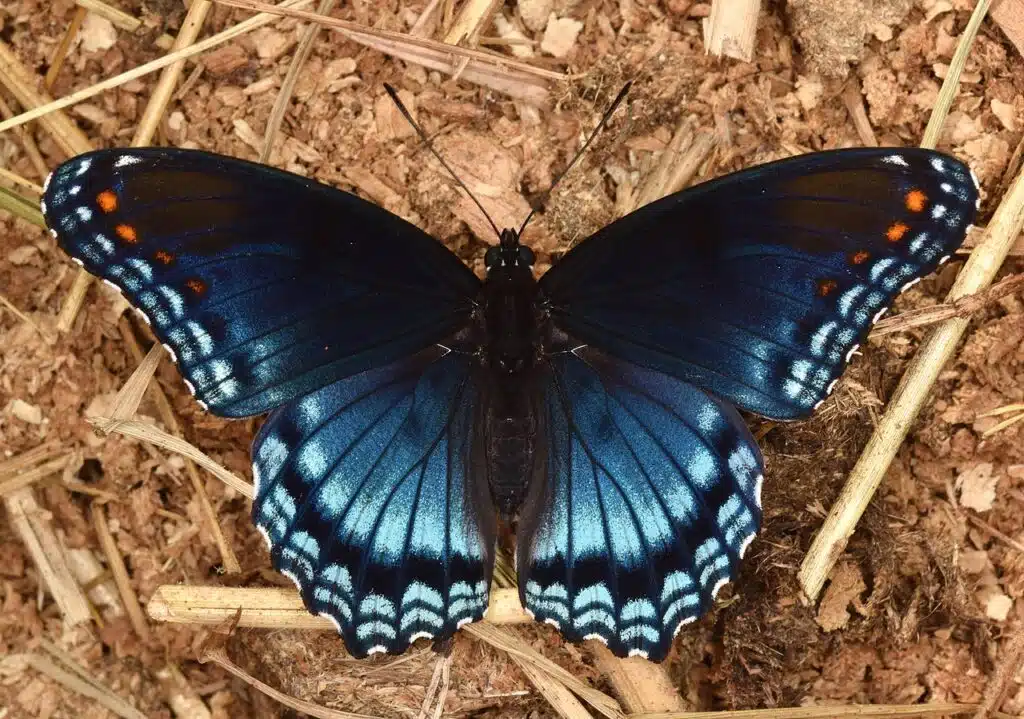
The Red-spotted Admiral (Limenitis arthemis) is one of the common blue butterflies. It has a wing spread of up to 3.5 inches as an adult which exhibits its multiple shades of blue.
The top part of the wings is black turning into a gradient blue where the dark blue is close to the top of the wings and the light blue is seen at the bottom of the wings.
Dark blue margins are also seen on the bottom of the wings.
The species might imply these butterflies have red coloring, but they only show small orange dots at the bottom of the wings.
This species is common in the US with a significant presence in a state such as Florida, New Hampshire, and Vermont.
2. Pipevine Swallowtail
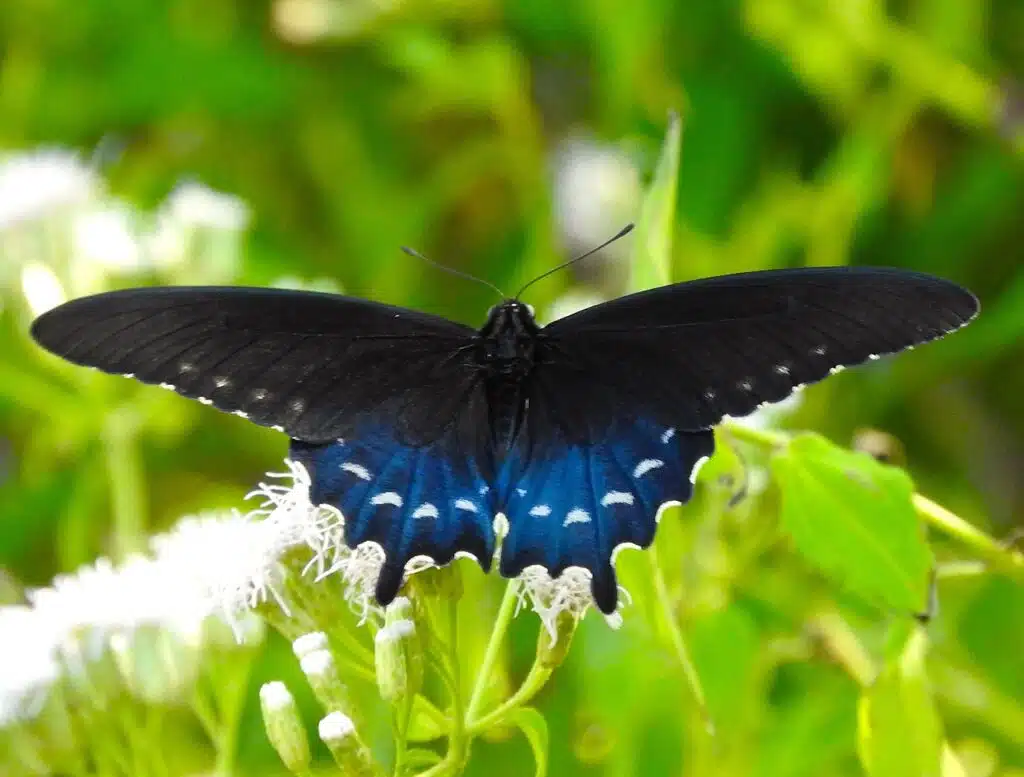
The Pipevine Swallowtail (Battus philenor) is a species somewhat similar to the Red-spotted Admiral. This butterfly has blue wings but the top of the wings is back.
As opposed to the Red-spotted Admiral, the Pipevine Swallowtail is one of the butterflies where wings are dominantly black and vivid blue on the bottom.
Coloring differences between the sexes exist.
Male Pipevine Swallowtails have a more pronounced vivid blue wings coloring compared to females.
Both can have a wingspan between 3 and 5 inches.
The species has an interesting distribution in the US. Most Pipevine Swallowtails live in Southeast US states while a disconnected population of the species is found in Western California.
3. Holly Blue
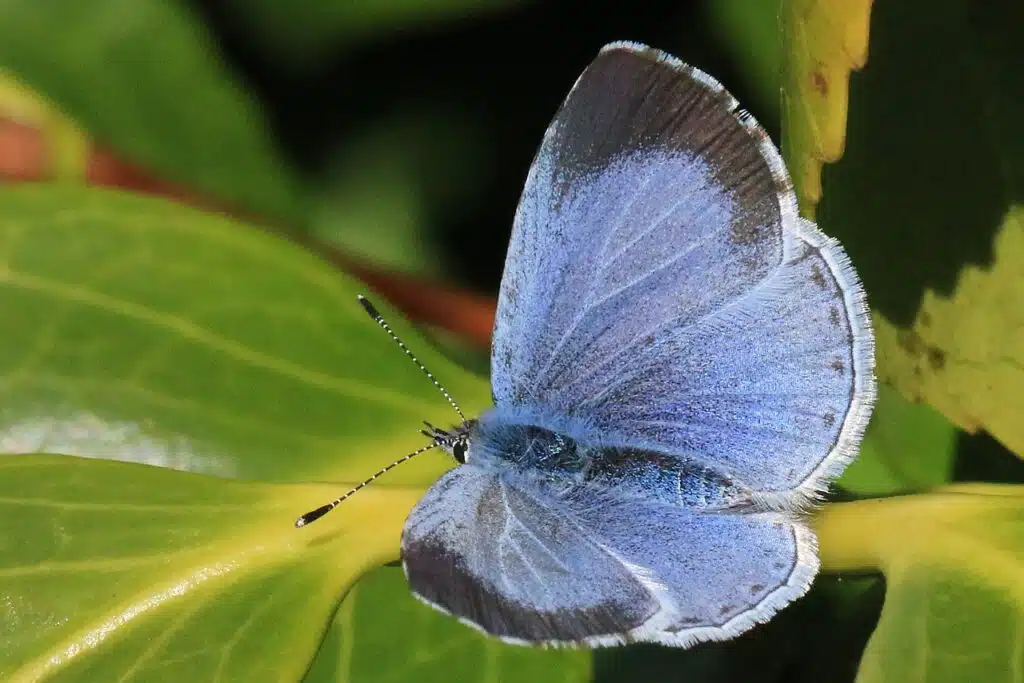
Holly Blue butterflies (Celastrina argiolus) have a bright color where blue is dominant. where blue is dominant.
The blue color of these butterflies has a violet nuance.
There are white and black margins around the wings, but these are barely visible.
Small differences are seen when it comes to the coloring of males and females.
It’s the male that has a wider percentage of almost uniform violet-blue coloring while the female has wider black margins.
These butterflies appear in 3 generations in the summer. They’re a common sight around ivy.
4. Eastern Tailed-Blue
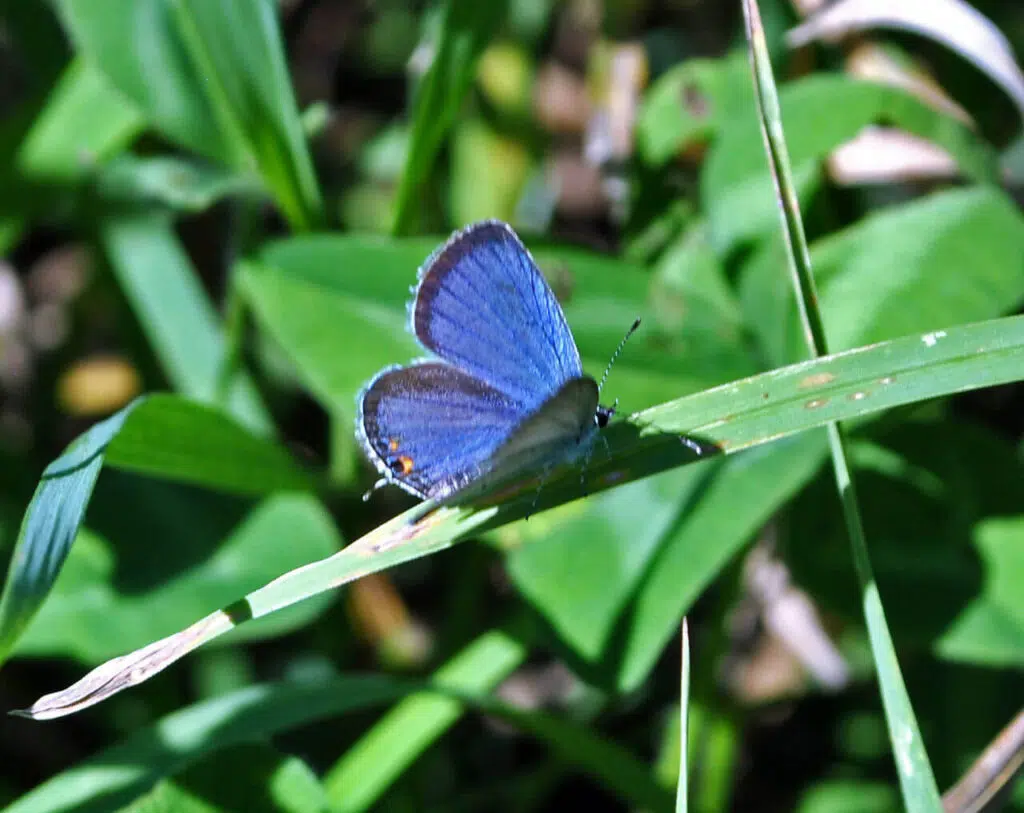
These butterflies (Cupido comyntas) are highly common in North America.
Coloring differences between males and females might sometimes make correct species identification difficult.
Male butterflies have a dark blue color with black and white wing margins.
Females look completely different with a charcoal color. Their wings also exhibit orange spots.
Both female and male Eastern Tailed-Blue butterflies are also found in different colors including purple.
This is one of the most common small blue butterflies in Eastern North America as its wingspan can measure between 0.83 and 1.14 inches as adult butterflies.
5. Long-tailed Skipper
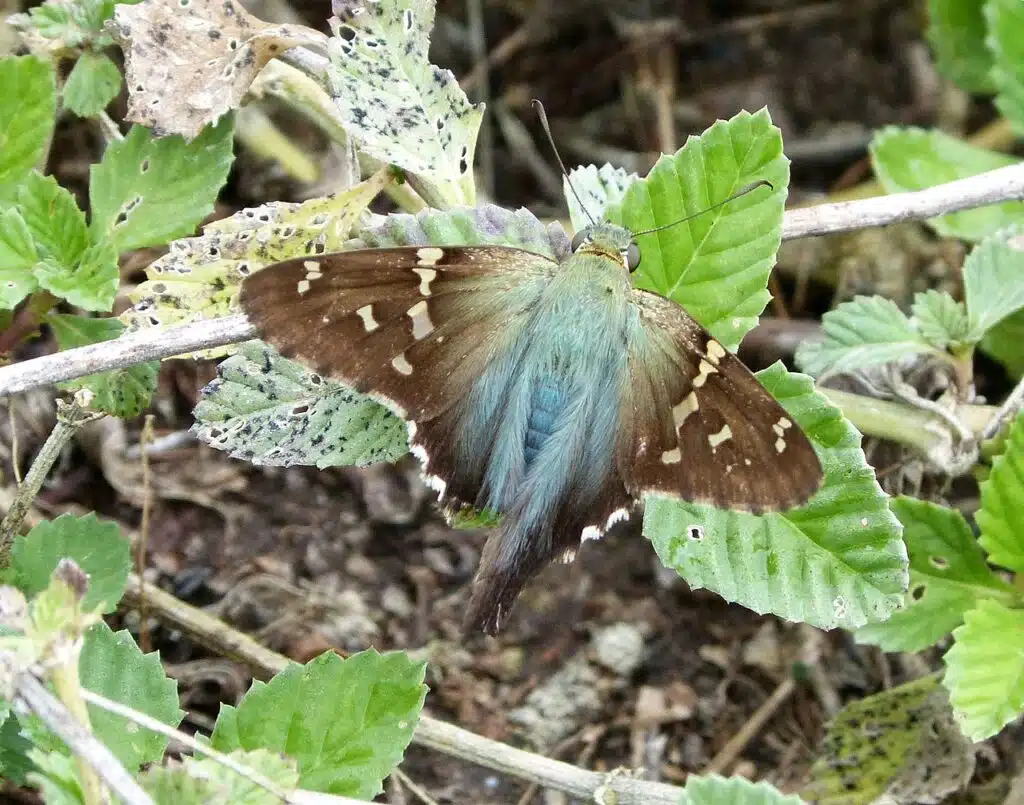
The Long-tailed Skipper (Urbanus proteus) gets its name from its 2 long tails in the central area of its wings. This area is blue and so are its long tails.
The species is native to South America but it’s now present in North America’s Eastern regions.
Butterfly of this species has an iridescent blue color with brown wing margins.
It has a brown ventral which makes it more difficult to spot from certain angles. Its predators include wasps.
The Long-tailed Skipper can be seen eating pollen during the day.
6. Summer Azure
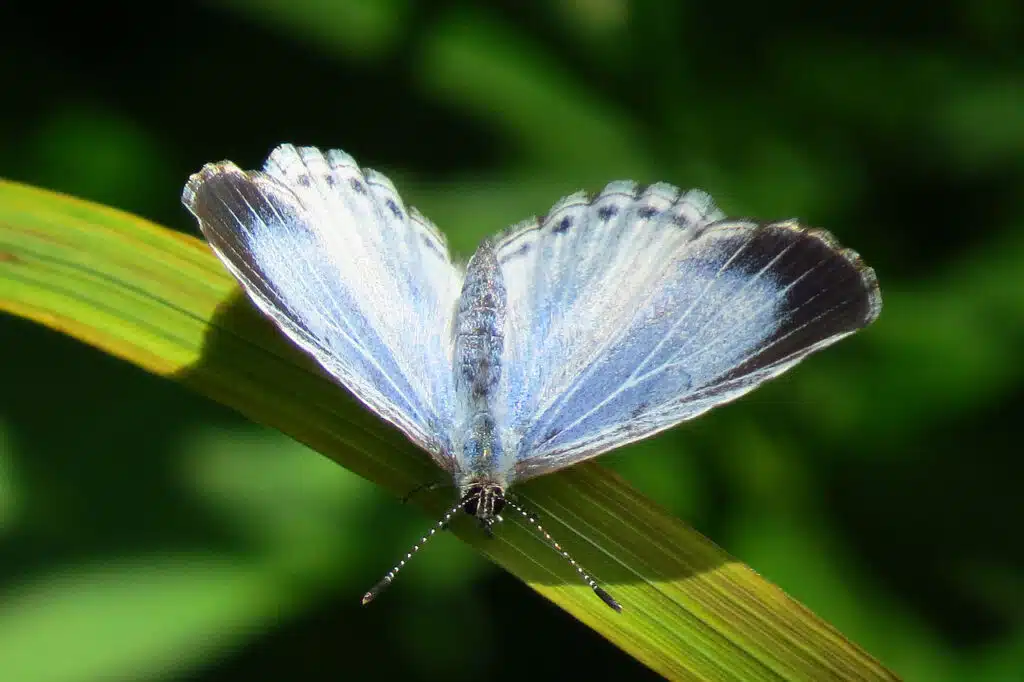
The Summer Azure species (Celastrina neglecta) gets its name from its summertime colors which are bright and almost white in some cases.
These butterflies have a bright blue wing color which is characterized by a white overlay that resembles white dust.
Some females are known for having an almost completely white coloring.
Black wing margins are common in the males and the females of the species.
Butterflies of this genus have an almost white ventral color which makes them easy to spot when eating pollen.
The species has a long flight season. These butterflies emerge in June and they continue flying until early October.
Eastern US parts are where this species is most common.
7. Silvery Blue
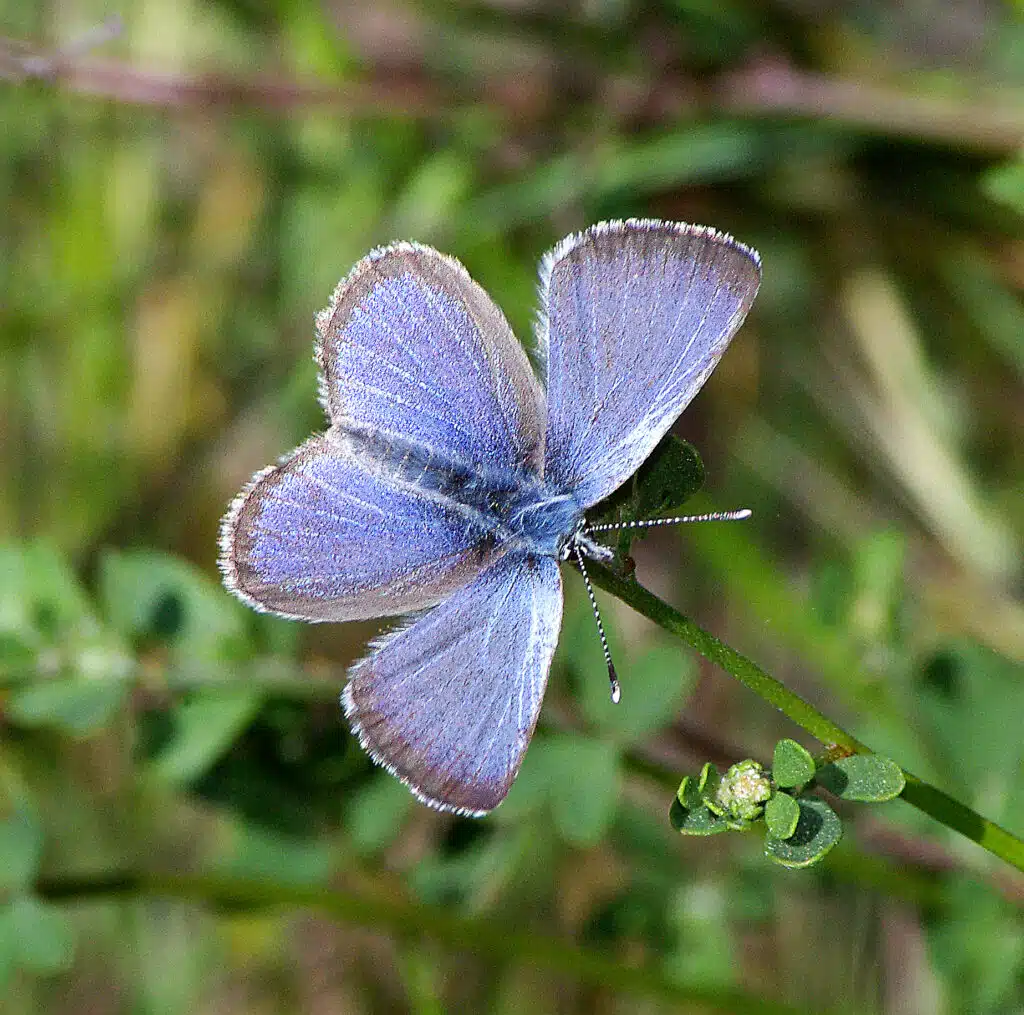
Silvery Blue butterflies (Glaucopsyche lygdamus) are a common species across the US.
These bright butterflies are seen in various states twice per year, typically early in the season.
One generation of Silvery Blue butterflies is seen in March to June intervals while the second generation flies from June to August.
Silvery Blue butterflies get their name from their blue color with a silver nuance.
Males have light blue coloring and are easier to spot.
Females look similar but they have a darker blue color. They have reduced silver nuances on their wings and they also have black margins around the wings.
These butterflies can be spotted in warm months in regions rich in asters and similar wildflowers.
8. Echo Azure
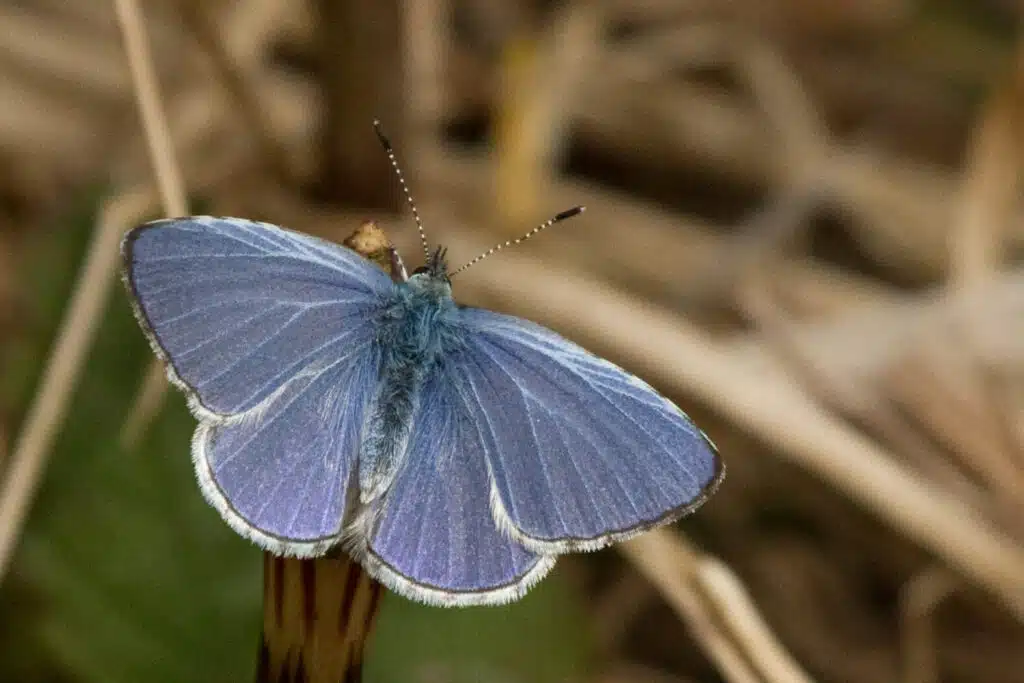
Echo Azure butterflies (Celastrina echo) are seen in a few generations from spring to fall, especially if there are no freezing temperatures.
This species grows to a size of just over 2 inches in wingspan and it can be identified by its blue color with a gray undertone.
Black marks are visible on each triangular shape these wings show as well.
Echo Azures lay eggs directly on flowers, as most Azure butterflies.
These butterflies live in Western US territories.
It’s here they can feed on Toyons, a type of shrub that sometimes resembles the scent of hawthorn.
9. Adonis Blue
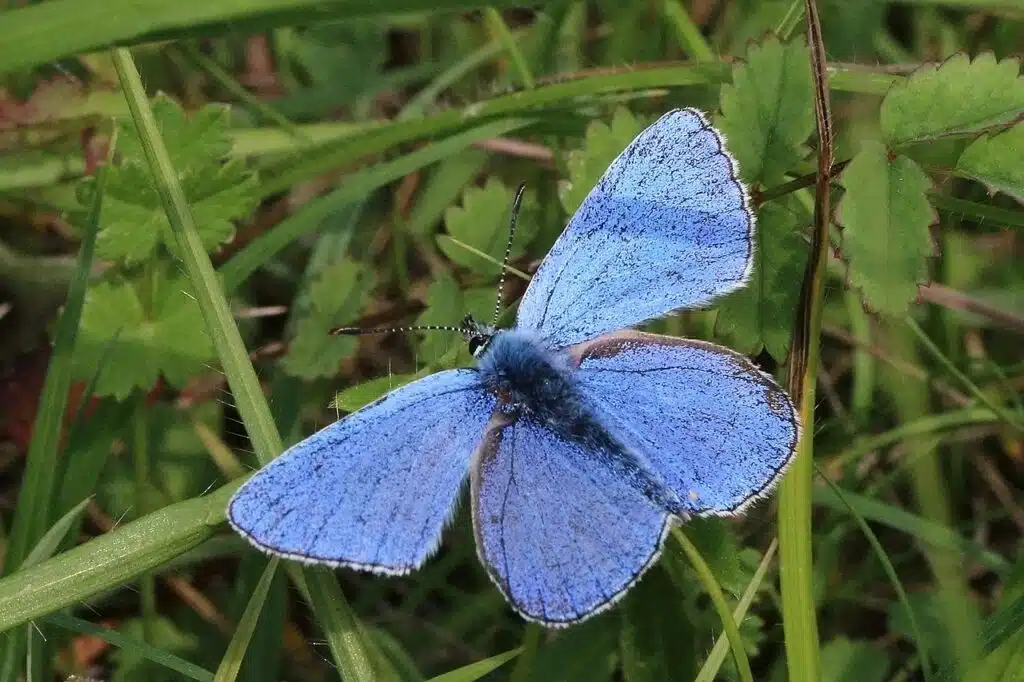
The Adonis Blue butterfly (Polyommatus bellargus) is a common species around the world.
The male Adonis Blue gives the name of the species with its sky blue color and black wing margins.
The wingspan of the species measures just over 1 inch.
Females of the species look different by having a chocolate-brown color.
Females have a few blue overlays in the ventral area of the wings but their orange spots on the bottom of the wings are most visible.
This species only lives in warm dry climates. It’s here that it can lay its eggs on horseshoe vetch flowers.
10. Boisduval’s Blue
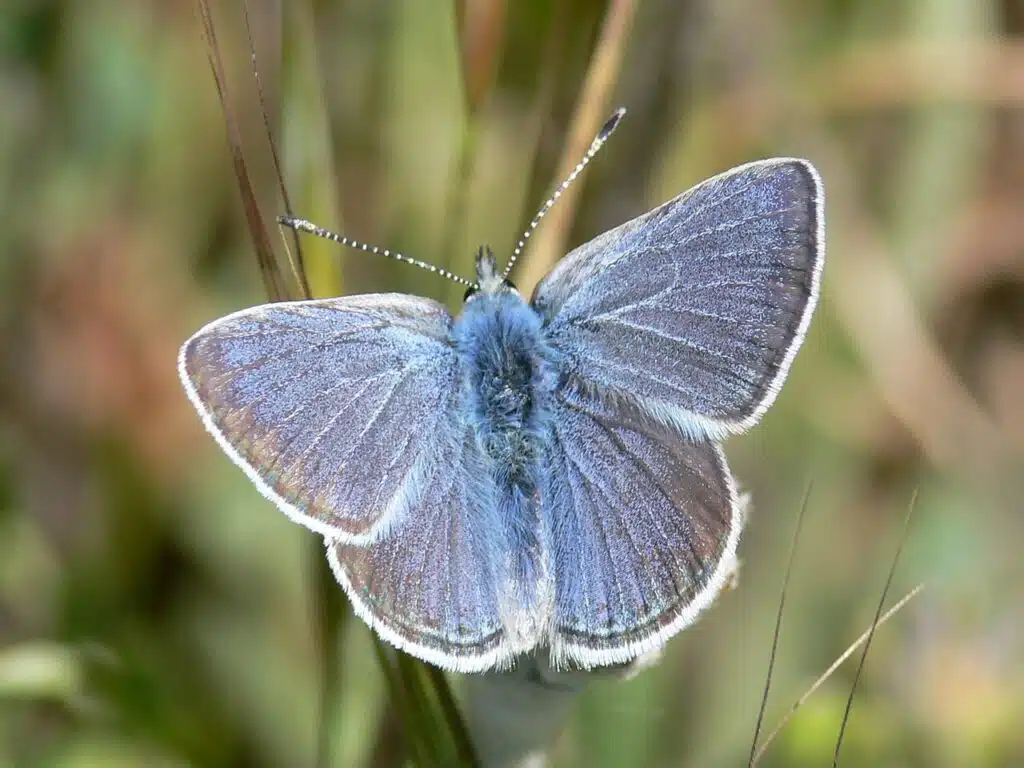
Common in North America, this species (Icaricia icarioides) is seen in more than 25 subspecies, all with similar blue coloring.
Boisduval’s Blue butterflies have a dark blue color with black intercalations and gray overlays.
The wings of the butterfly show a fine black bordering line followed by a wider white border just on the edge of the wings.
Butterflies of this genus love mountains of Western North America.
They are seen in open areas at high altitudes, especially on meadows and next to streams.
Like other butterflies, Boisduval’s Blue has its nectar preferences. They only feed on wild buckwheat nectar.
11. Chalkhill Blue
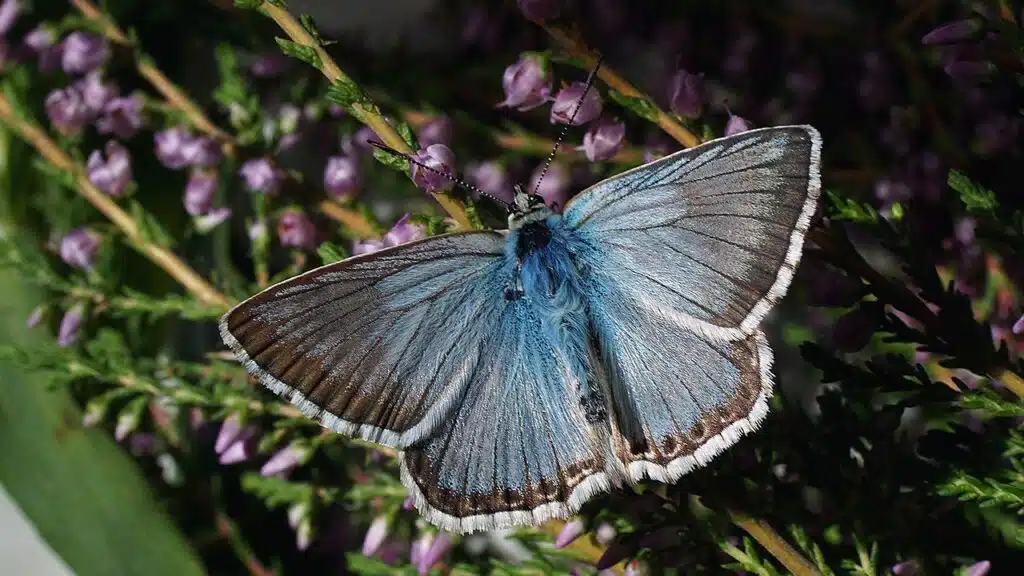
The Chalkhill Blue (Polyommatus coridon) lives on thin soils on chalk and limestone known as calcareous grasslands.
Most of these soils are found at high elevations. The species is present in high grasslands at altitudes of up to 6.000 feet.
The Chalkhill Blue butterfly gets its name from its habitat but it’s only the male that’s blue.
Male Chalkhill Blue butterflies have a dark blue and light blue color whereas the lighter coloring is seen towards the edges of their wings.
The margins of the wings have a black border with a slight black gradient. An outer white border is also specific to both the male and the female.
Female Chalkhill Blu butterflies have a tan-brown color with blue overlays on the body.
12. Spring Azure
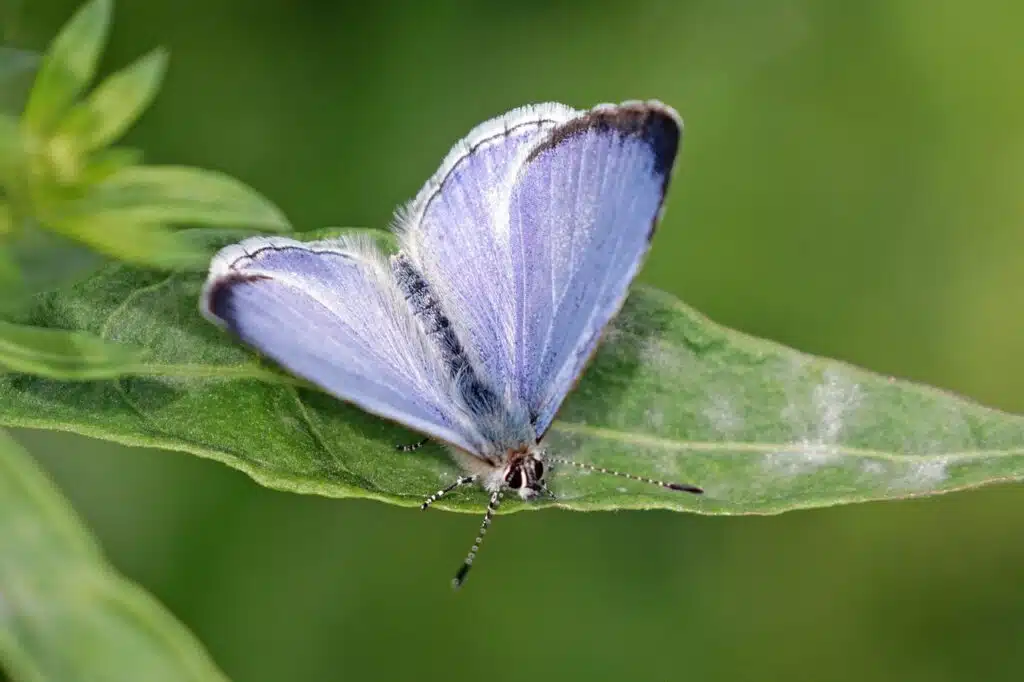
Spring Azure butterflies (Celastrina ladon) are among the few Azures that have very similar coloring between males and females.
The Male Spring Azure has a darker violet-blue color while the female has a bright violet-blue color.
Both have black and white margins around the wings but the female has wider black margins.
Common in Florida, Texas, and other Southeastern habitats, these butterflies can only be separated by the width of the black bordering of their wings.
Both males and females are small to medium in size as they can grow to a wingspan of up to 35mm.
13. Common Bluebottle
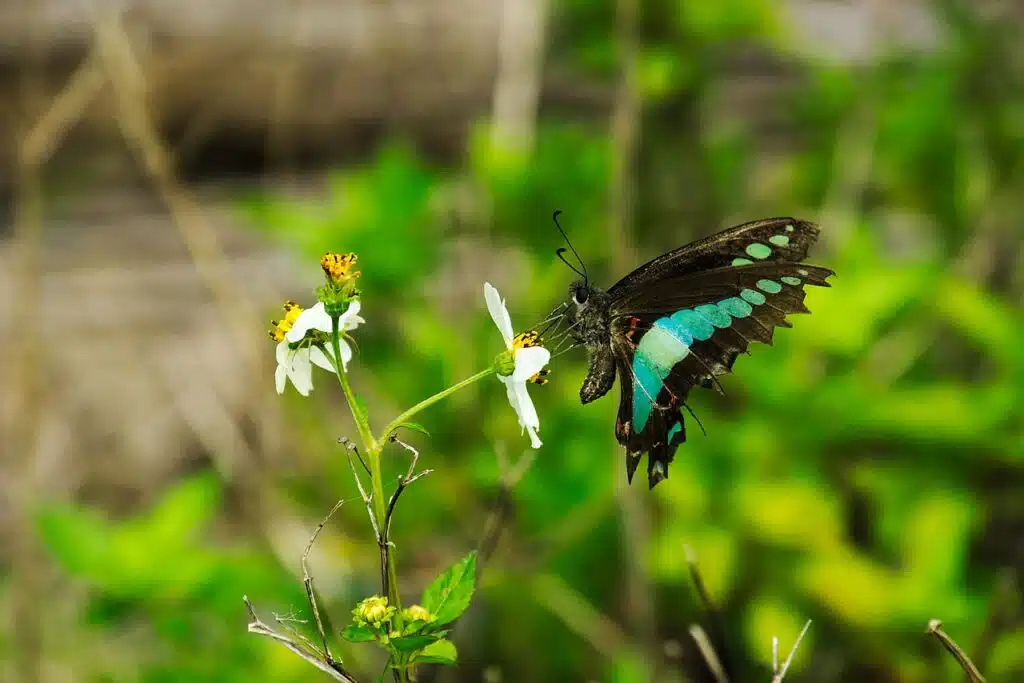
The Common Bluebottle butterfly (Graphium sarpedon) is a widespread species found in multiple natural habitats.
Seen on Common lantana flowers around the world, the Common Bluebottle is a species known for its colorful appearance.
The central portions of its wings are aquatic-blue. The edges of the wings have thick black borders while the body has a gray color.
Small blue spots are also seen on the sides of this species. The head and antennae are black.
Tropical and subtropical climates are the favorites of the species.
These butterflies have an innate ability to follow flowers even if these flowers are found in suburban areas.
14. Blue Pansy
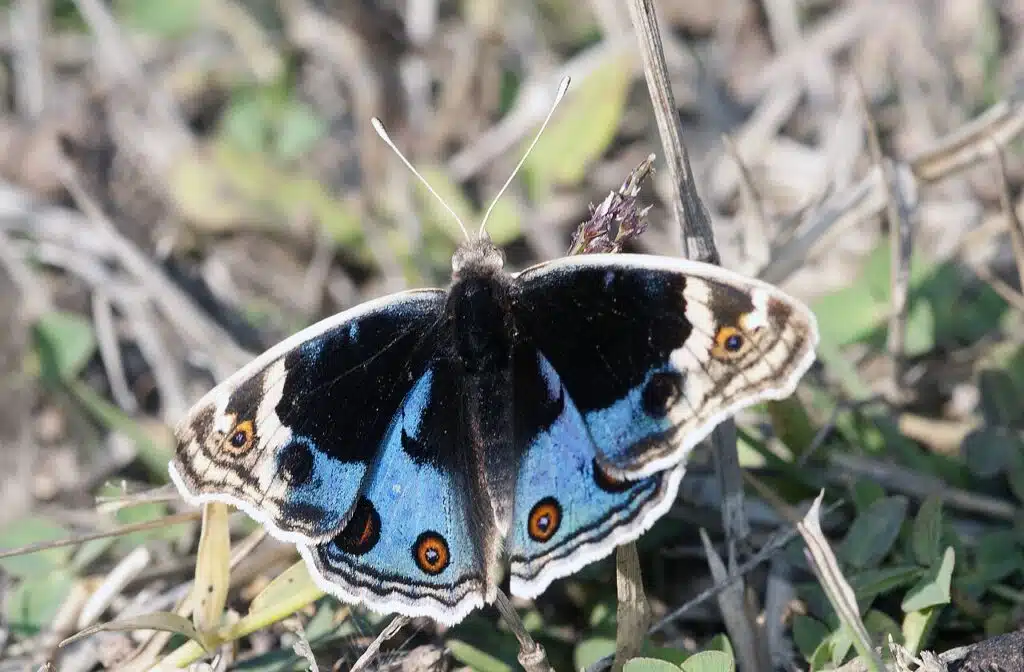
The Blue Pansy butterfly (Junonia orithya) is known for its orange-bordered ocellus-like coloring on its blue wings.
These orange circles with black borders are found on a dark blue background with black upper wings.
Only the hindwings are blue but these colors are more vivid on the female Blue Pansy.
Seen on various flowering plants and shrubs, Blue Pansy are butterflies that are often seen sitting on bare ground in open areas.
Also known as the Eyed Pansy, this species is common in Africa, Australia, and other warm climates around the world.
15. Great Mormon Swallowtail
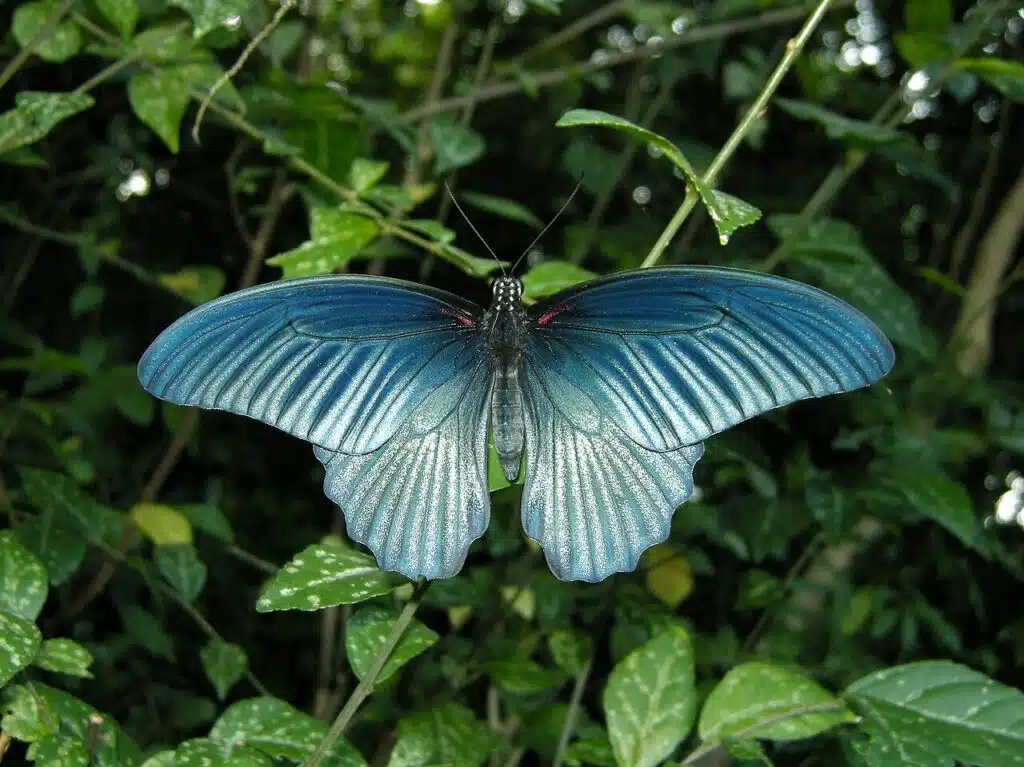
The Great Mormon Swallowtail (Papilio memnon) is one of the dark blue butterflies that almost appears black and is present in multiple territories around the world.
Its upper hindwings have a navy blue color which is close to black.
These butterflies don’t have tails but they appear different in genders.
Females have more white coloring while males have lighter blue wing coloring in addition to the navy blue females exhibit.
Great Mormon Swallowtails are types of blue butterflies common in areas with citruses.
16. Northern Azure
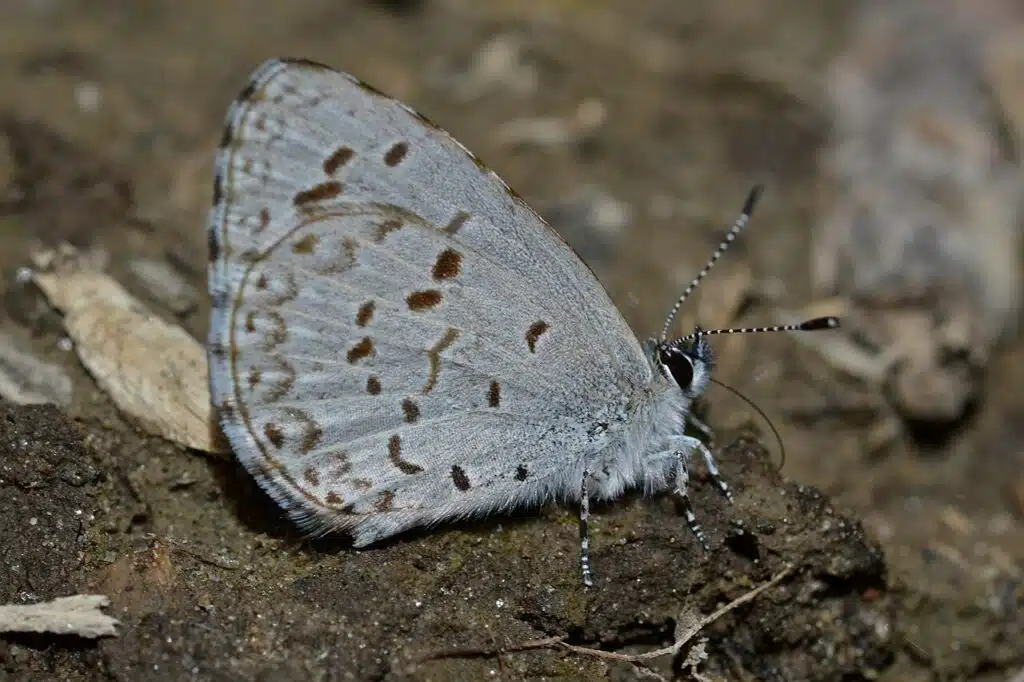
The Northern Azure (Celastrina lucia) is one of the bright blue butterflies. This species has a wingspan of at least 22mm.
Northern Azures are sexually dimorphic. This means males look completely different from females. The sizes of the sexes might be comparable, but not the coloring.
Only the male Northern Azure butterfly has a bright blue color with white overlays and marks.
The female has a darker richer color. Brown marks on a tan and yellow body are specific to the Northern Azure female.
The larvae of the Northern Azure butterfly are difficult to correctly identify as its coloring varies according to what it eats. Some Northern Azure larvae have a yellow color while others are green.
17. Common Morpho
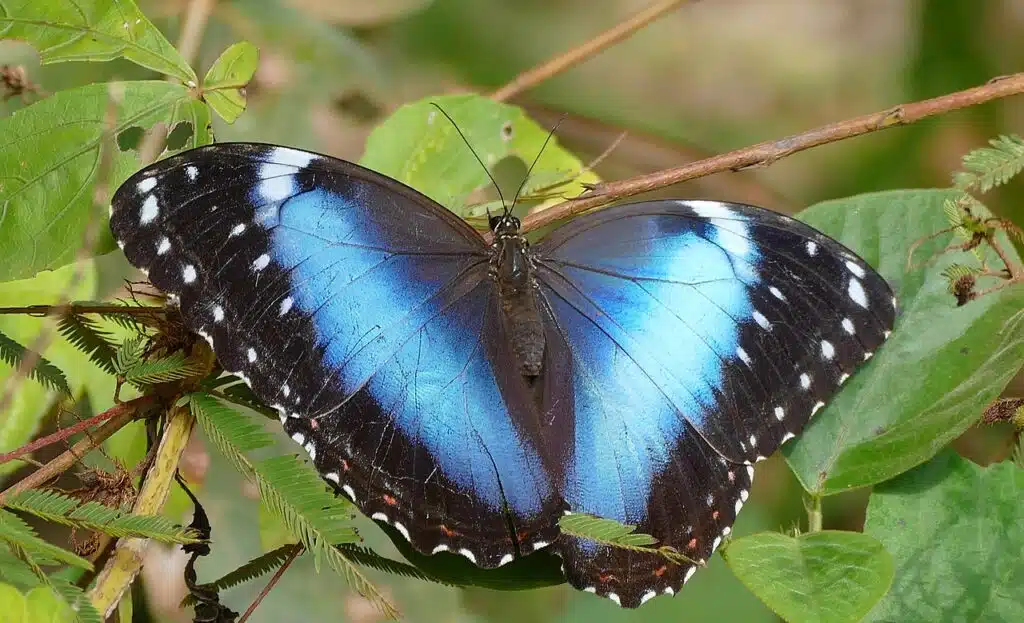
Found in the tropical forests of North and South America, the Common Morpho butterfly (Morpho helenor) is another species with dominant blue coloring for males.
As Northern Azures, Common Morphos are also sexually dimorphic which means males and females have different appearances.
Males have a blue gradient color which is darker towards the body and lighter on the outer wings which also have thick black bordering.
Females have a brown body with small blue, white, and black marks.
Both adults and larvae of Common Morphon feed on multiple flowering plants. All of these plants are specific to warm-climate tropical and sub-tropical forests.
18. Cassius Blue
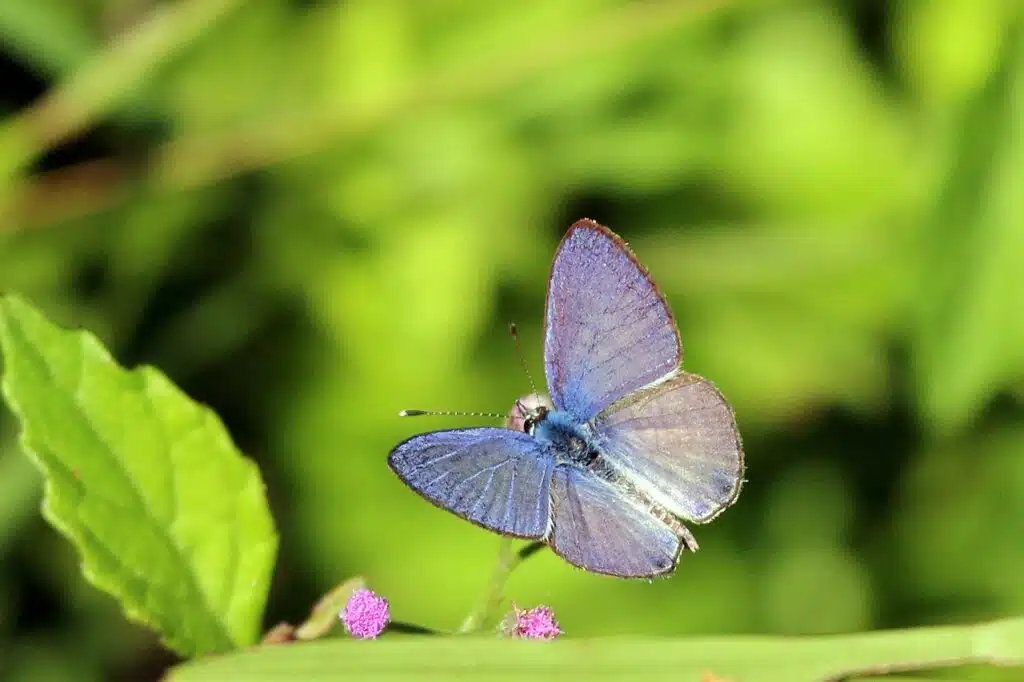
Cassius Blue butterflies (Leptotes cassius) are one of the sensitive species of butterflies that only survive in the warmest areas of the US which are Peninsular Florida.
Cassius Blue butterflies may sometimes be seen in Northern Florida but they only live in the Southern parts of the state.
This species is dominated by a pale and blue appearance. Males have light blue hindwings with pale yellow to white lower wings with gray margins.
Females have a pale lime to white appearance with gray to tan markings and round black and blue markings.
The species is known as sensitive and dies immediately with sudden temperature drops.
19. Lupine Blue
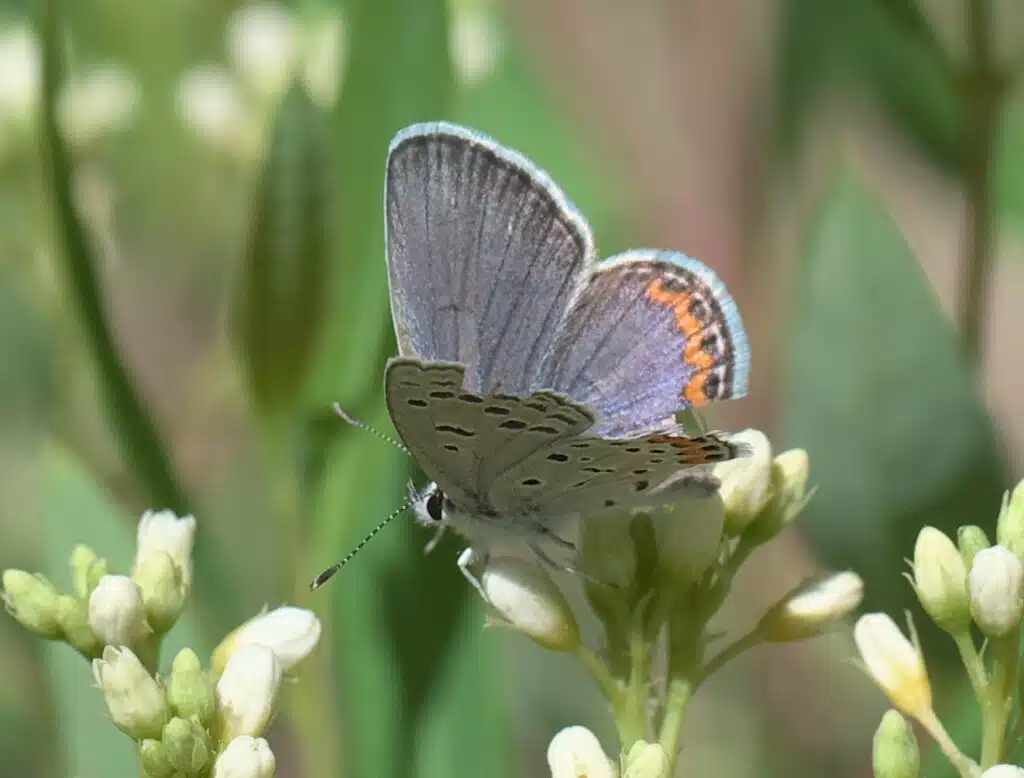
Lupine Blue butterflies (Icaricia lupini) are seen at the beginning of the summer or through the summer depending on the weather conditions.
It lives through July and August in California and a bit less in other regions.
These butterflies have a violet-blue color with pink to red markings, black margins, and white margins or bordering around the wings.
A slight metallic hue is also characteristic of the species and also acts as a warning sign to stay away from Lupine Blue butterflies.
Touching these colorful butterflies can cause skin irritation.
Adult butterflies are always seen on flowers. They feed on flower nectar during the day.
20. Blue Tiger
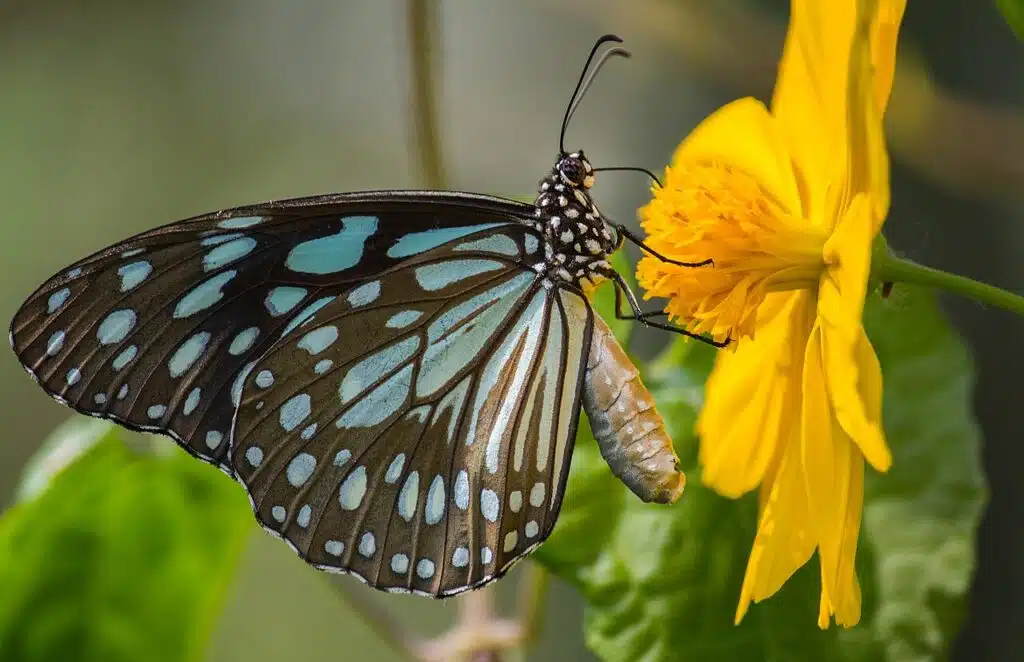
Blue Tiger butterflies (Tirumala limniace) use the warmth of the sun to fly. They can absorb heat and the coloring of their wings is largely responsible for this ability.
Males and females have a similar appearance even if males are smaller than female Blue Tigers.
They have a brown or black color with multiple blue to white large and small spots across the wings.
There are now thin or wide borders on the wings of this species.
Blue Tigers are mainly common in Southern Asia. The species can be found in the Indian Subcontinent and further East in Southern China and Philipines.
21. Common Hedge Blue
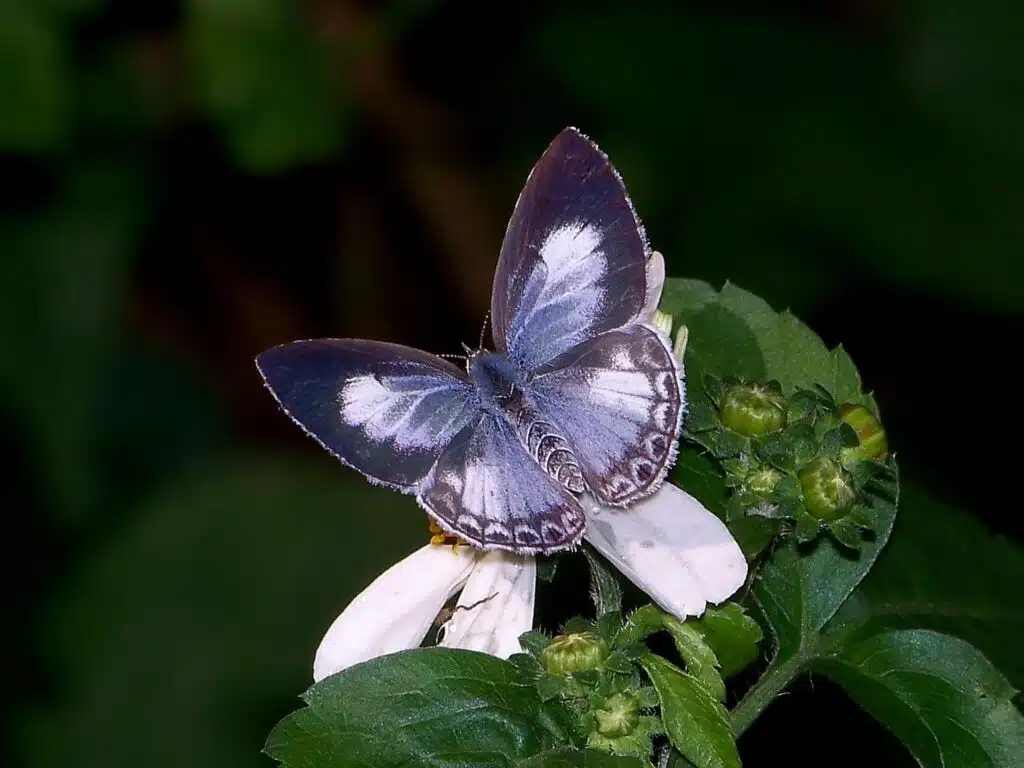
Common Hedge Blue butterflies (Acytolepis puspa) have an iridescent blue color. This means it changes its appearance depending on the light that falls on its wings.
The Common Hedge Blue butterfly can be blue, violet-blue, or even pink-blue. The red-violet overlays on its blue wings make it appear colorful.
The Common Hedge Blue butterfly is also one of the few species that has a light blue ventral color. With both sides a blue color, the Common Hedge Blue butterfly is one of the most representative species of this genus in Asia.
The specie is common in India, Sri Lanka, Myanmar, and the Himalayas.
22. Southern White Admiral
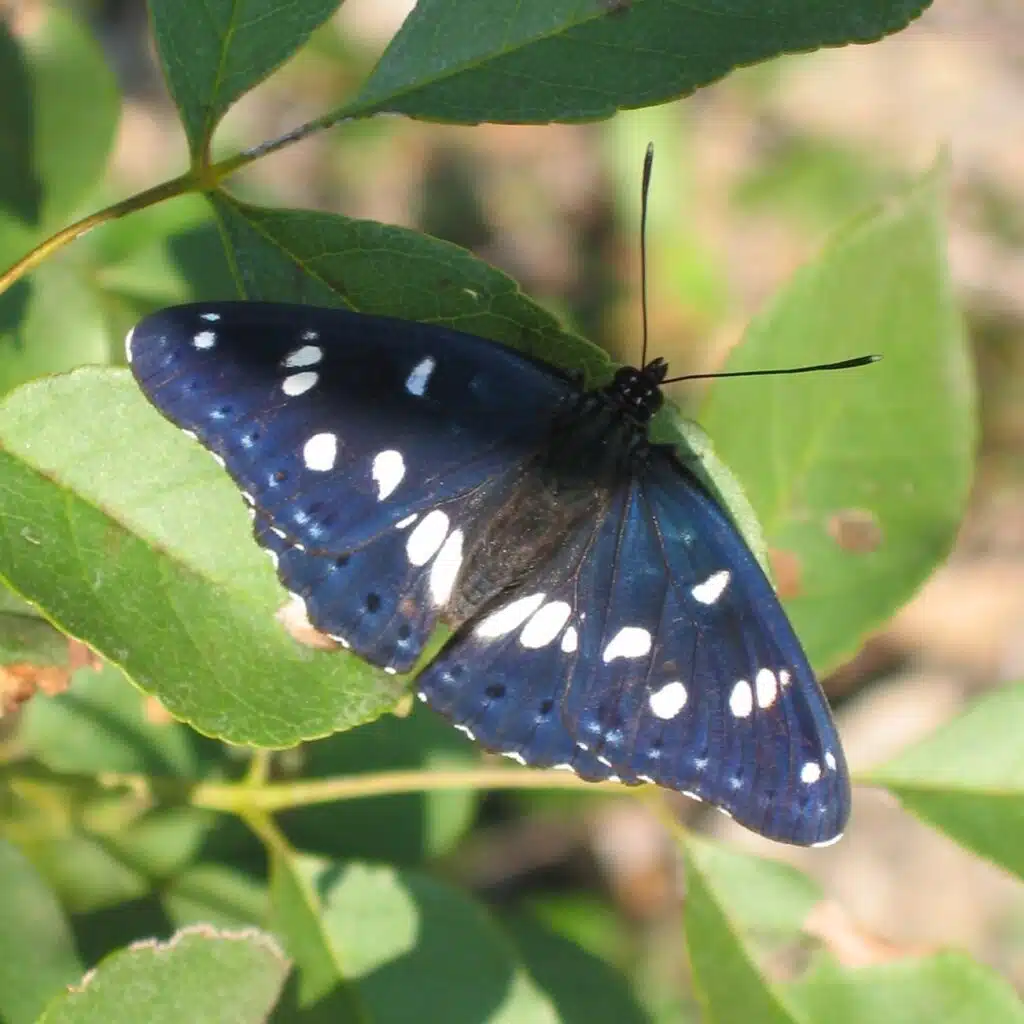
The Southern White Admiral (Limenitis reducta) has a dark blue color with a metallic appearance and violet-blue margins.
Bright blue or white spots are also visible on this species.
Butterflies of this genus also have a colorful ventral side which is dominated by red and white spots.
Found in Asia, the Southern White Admiral is adapted to living at high altitudes. It can be found in Syria, Iran, and neighboring countries at altitudes of up to a few thousand feet.
Southern White Admirals are found next to woodlands or in woodland openings.
23. Mazarine Blue
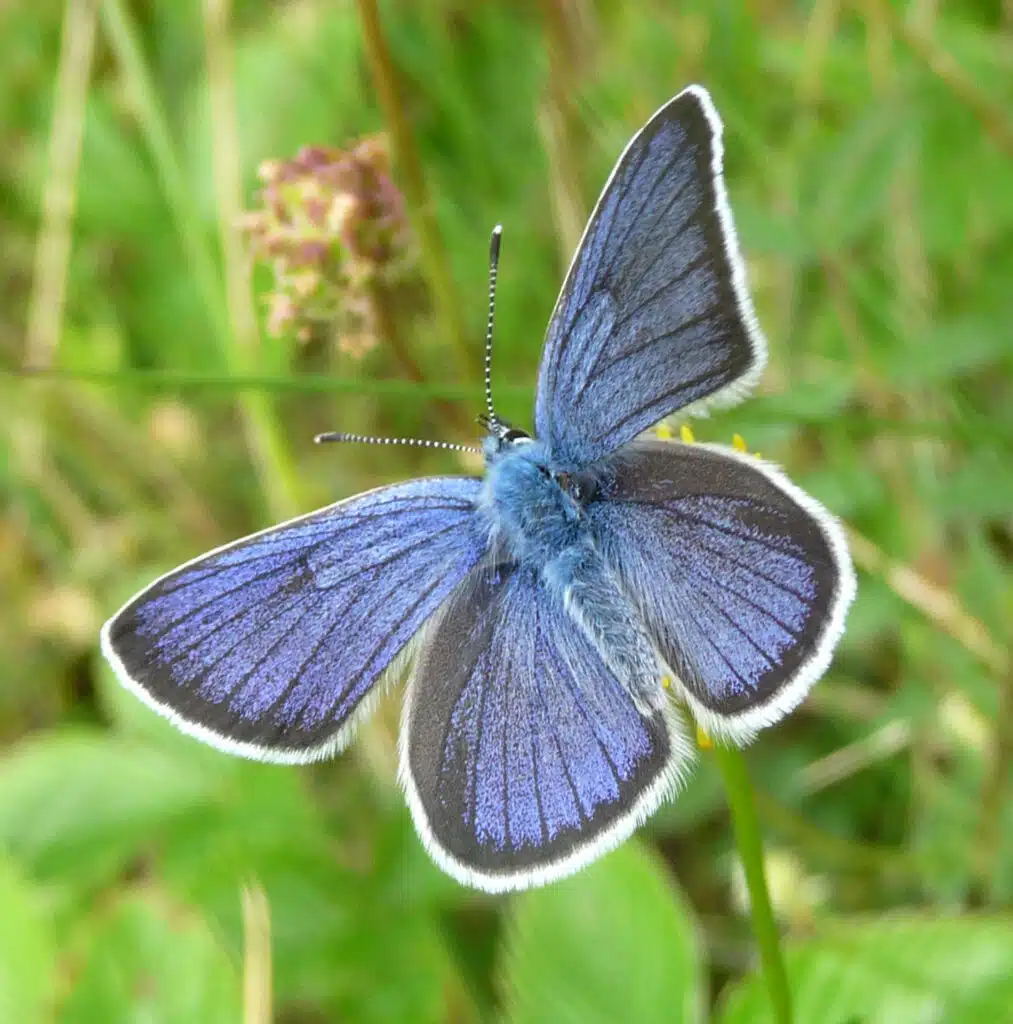
The Mazarine Blue species (Cyaniris semiargus) is common in Europe. Its widespread continental distribution makes it one of the most common blue butterflies in Europe.
The male is different from the female in coloring and visible venation. The male Mazarine Blue butterfly has blue to blue-red coloring with black and white margins.
Females have a bright blue body with dark blue marks.
The species is known to arise in the spring when the larvae that feed on Red clover emerge. Only one Mazarine Blue brood appears per season, typically starting from May.
You can see these butterflies in grasslands and pastures.
24. Common Jay
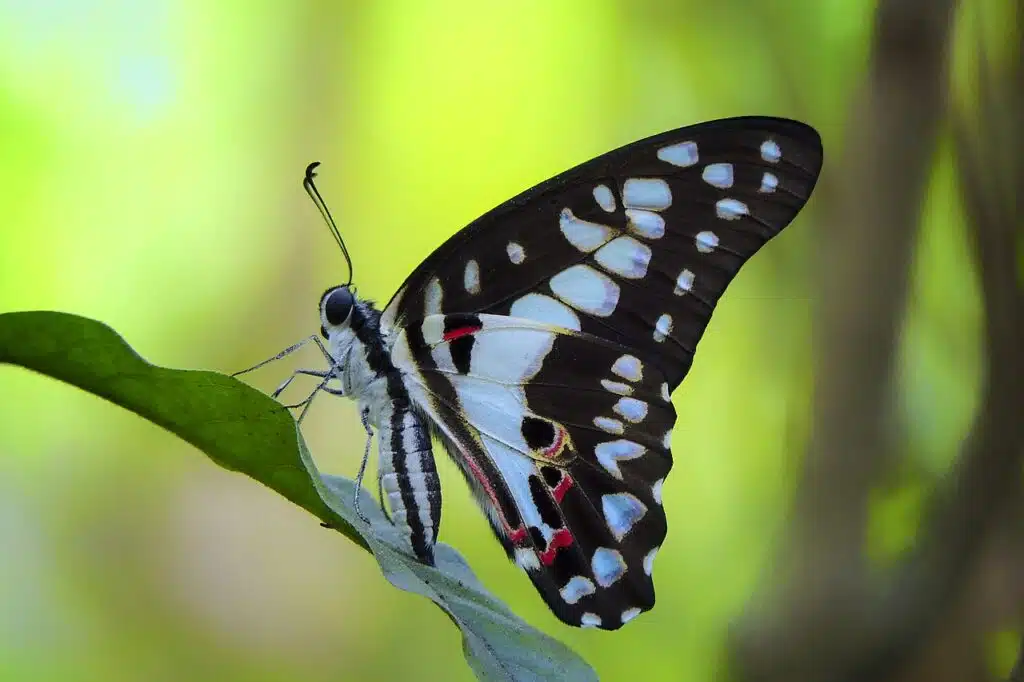
The Common Jay (Graphium doson) is one of the few blue butterflies without sexual dimorphism. This means males and females look widely the same.
They both have a blue and black color with small red marks on the wings. The blue section of the wings is translucent, almost see-through.
Common Jays also have a blue body.
Not common in North America, Common Jays are mostly seen in Southeast Asia.
These butterflies are common in Sri Lanka, Bangladesh, and India.
25. Spangle Swallowtail
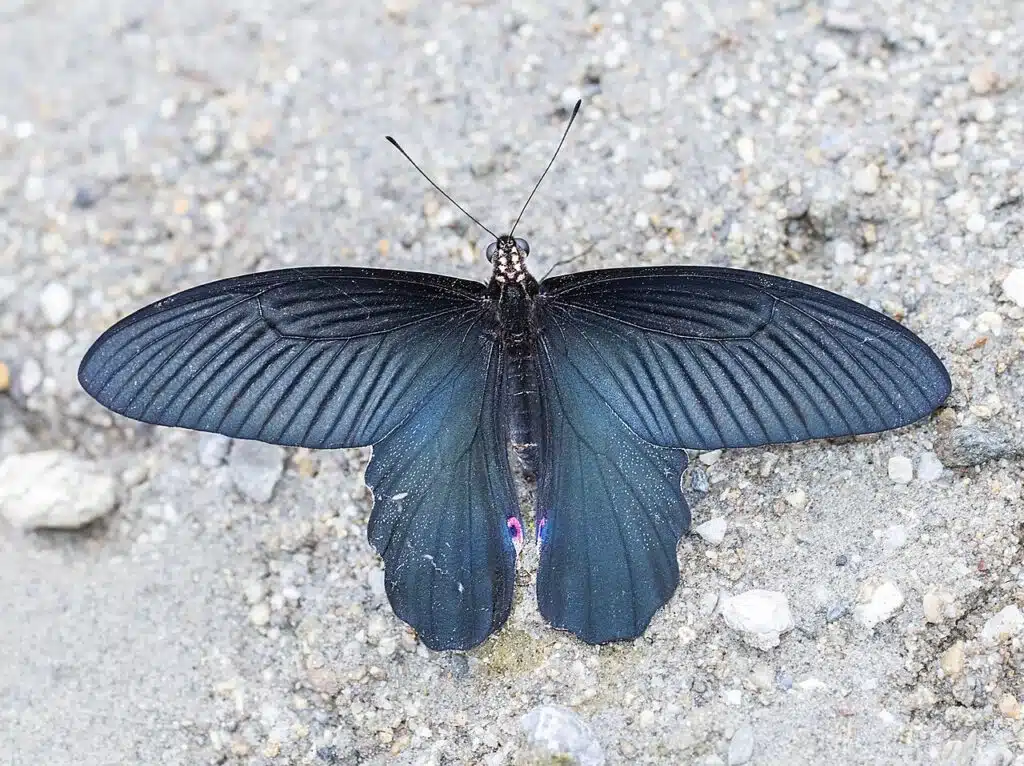
The Spangle Swallowtail (Papilio protenor) is a tail-free blue butterfly with unique streaks on the forewings.
These brown to black streaks are alternated with white streaks. The hindwings are blue with orange and white spots.
Females of the species have a mostly brown body and they are easily seen as a different species due to sexual dimorphism at times.
The male is dominant and this is also seen in their odors are males are also dominant when it comes to smell.
Blue butterflies of this species can be found in Asia, particularly in South Korea.
26. Blue Wanderer
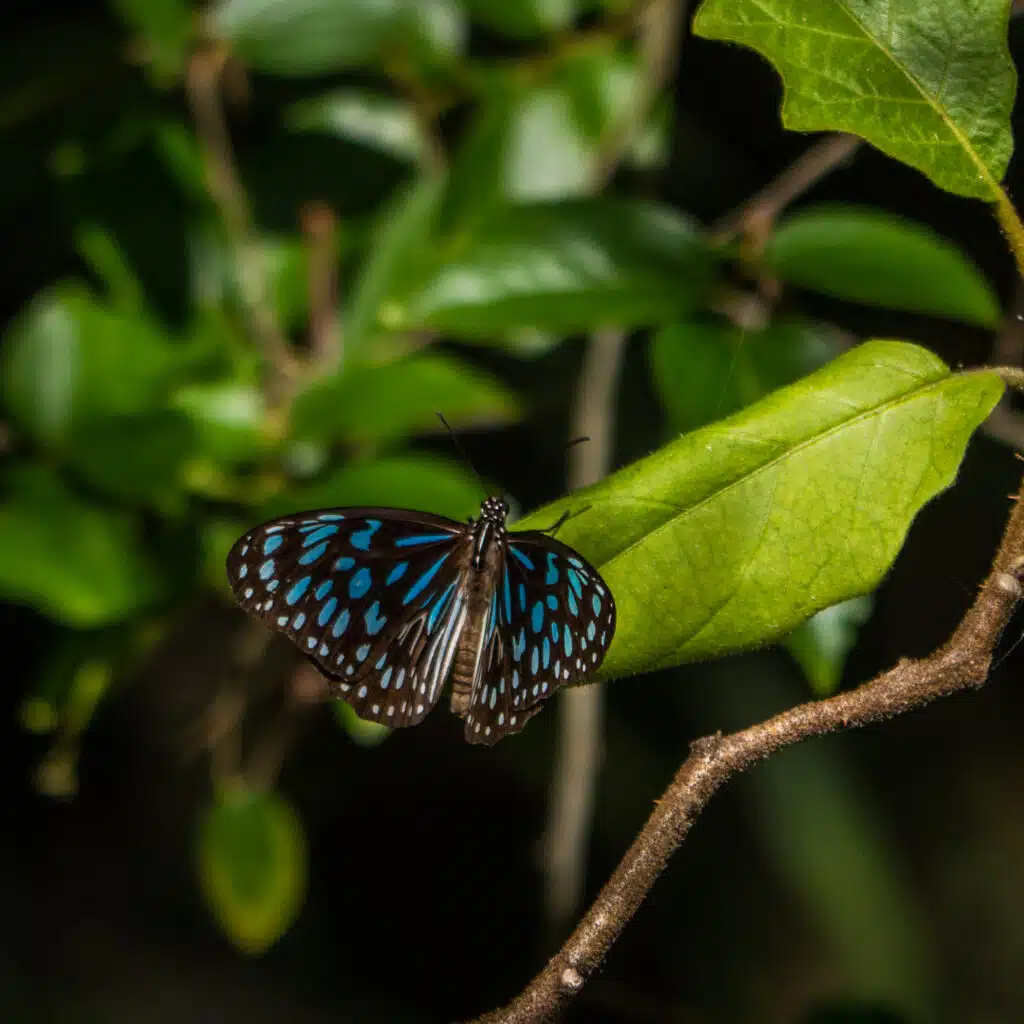
Blue Wandered butterflies (Tirumala hamata) are native to the Philippines and parts of Oceania.
These butterflies have a black main color with large light blue spots across the wings.
Females maintain similar characteristics but they have brown base coloring instead of black coloring as males.
Blue Wanderers are some of the largest species of black and blue butterflies with a wingspan of up to 70mm.
These butterflies feed on plant nectar and they’re often seen around flowering bushes and flowers.
Out of all flowers found in their habitat, Blue Wanderers prefer clasping heliotropes.
27. Green-underside Blue
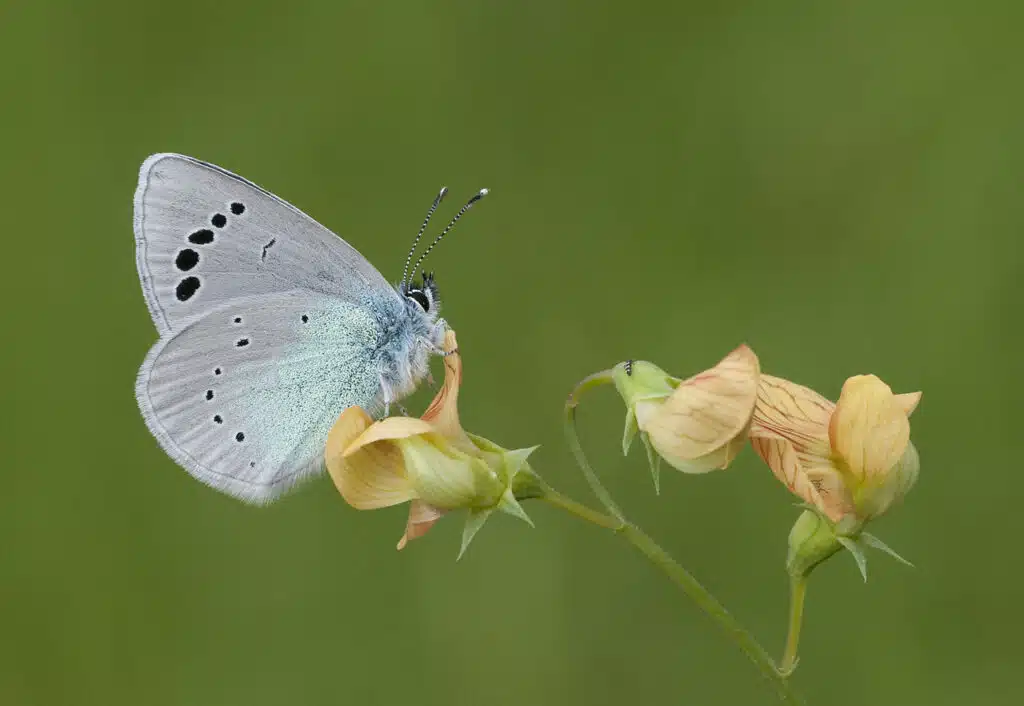
Commonly seen on plants such as vetches, Green-underside Blue butterflies (Glaucopsyche alexis) have both blue and green colors.
Their wings are light blue and they have a green to violet sheen metallic overlay known as a sheen which makes them shine in direct sunlight.
Males and females are similar albeit females have slightly darker colors.
Green-underside Blues are known for emerging early in the season in meadows and they live in very warm climates.
This is why it’s not atypical to see these butterflies in April. They have a flight season that continues to mid-summer.
28. Two-barred Flasher
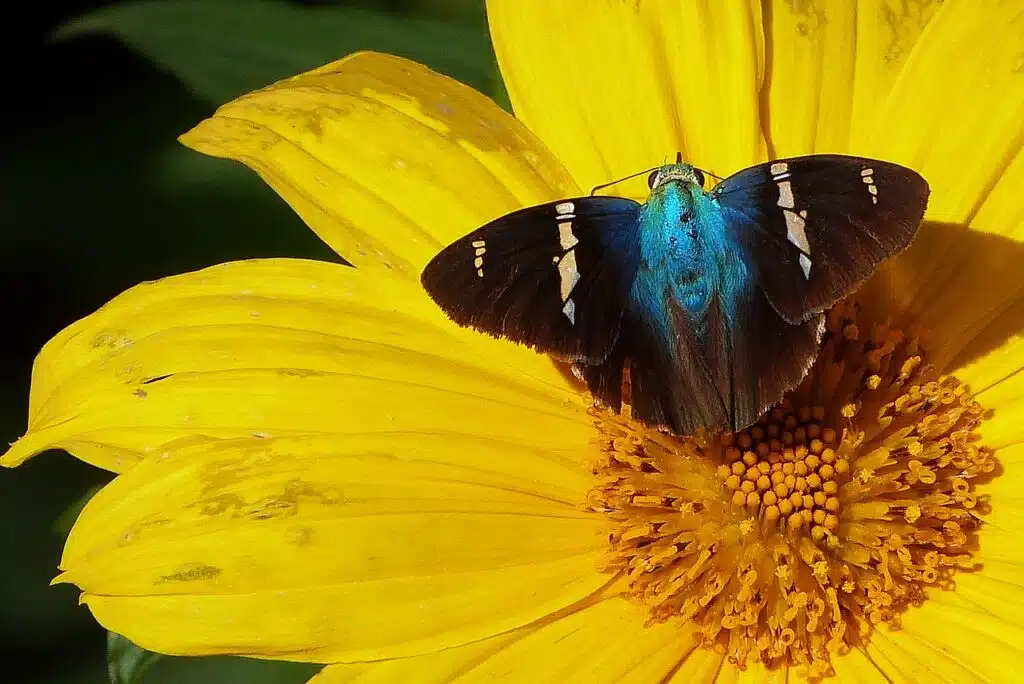
The Two-barred Flasher (Astraptes fulgerator) is a common butterfly with blue-brown coloring. The wings are partially blue and partially gradient brown. The brown color becomes lighter further away from the blue head.
Two-barred Flashers have an iridescent blue color which appears metallic and slightly silvery in direct sunlight.
These butterflies are common in North America and South America. Seen in Southern US, the species expands its range down to Argentina.
It’s also one of the few blue butterflies that like flowering legumes more than wildflowers.
It can be seen around the flowers of bean family legumes all the time.
Females of the species look different. They are dominated by dark brown and tan colors.
29. Mexican Bluewing
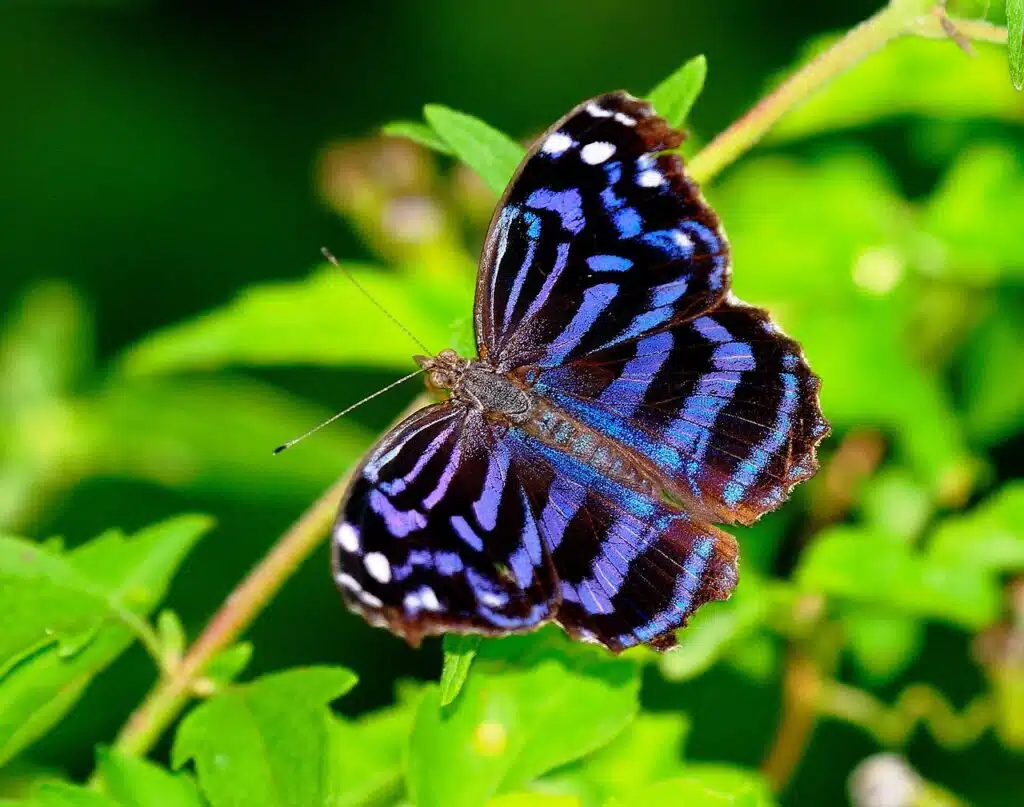
Mexican Bluewings (Myscelia ethusa) are a species of butterflies with black and blue-violet horizontal stripes.
This makes the species rather unique in its look.
Its habitat is also interesting. This species only crosses into the US in Southern Texas during the warmest months of the year.
Seeing a Mexican Bluewing might not be easy since this species is only visible when it flies.
Mexican Bluewings spend a lot of time on tree bark. Their closed wings are colored exactly like tree bark acting as camouflage and essentially making these butterflies invisible.
Ault Mexican Bluewings don’t feed on tree bark or pollen like many other blue butterflies. They prefer ripe fruit.
30. Sonoran Blue
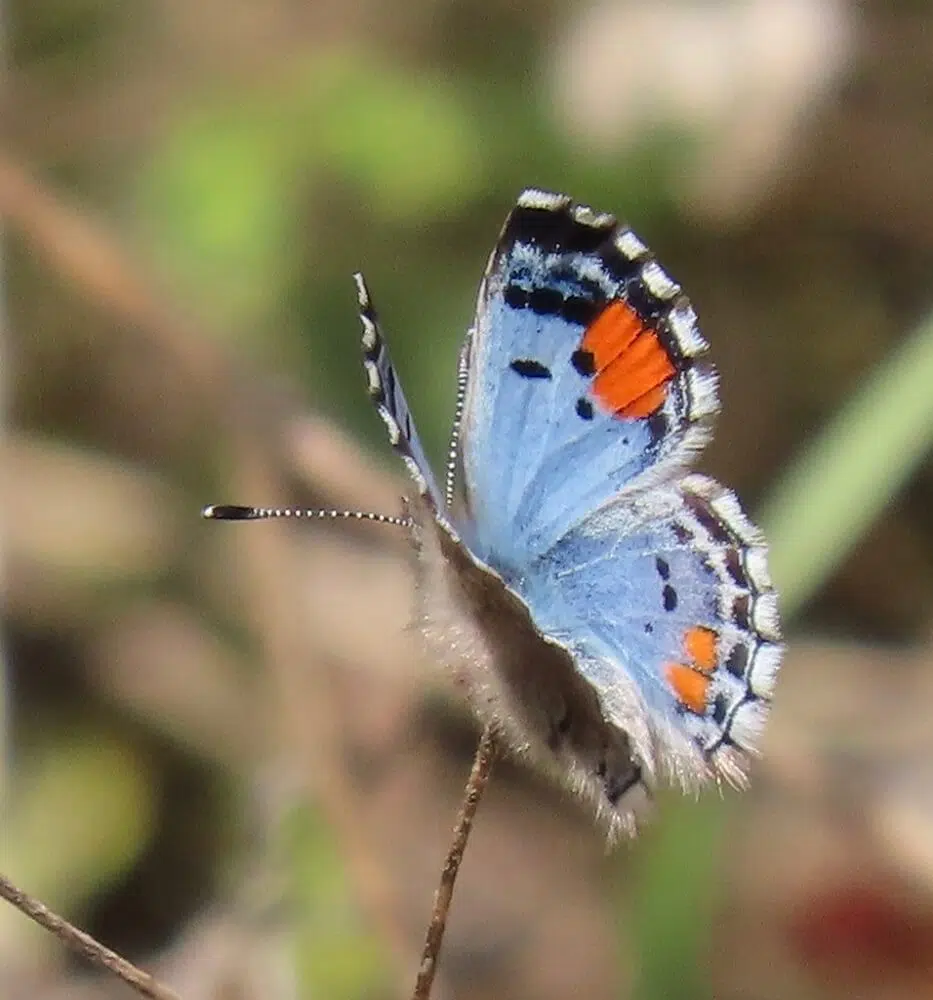
Common in California and Baja California, the Sonoran Blue butterfly (Philotes sonorensis) is characterized by vivid blue coloring in the case of males.
Female Sonoran Blue butterflies are brown with only a small blue section of their wings.
Butterflies of this genus have a mostly blue color in the case of males. They have black spots and red spots on their wings.
Some slight blue shade variations are seen on this species as the coloring isn’t uniform. Some sections of the wings are dark blue as opposed to light blue.
The larvae of the Sonoran Blue butterfly are found in various plants. It lives inside plants.
31. Amanda’s Blue
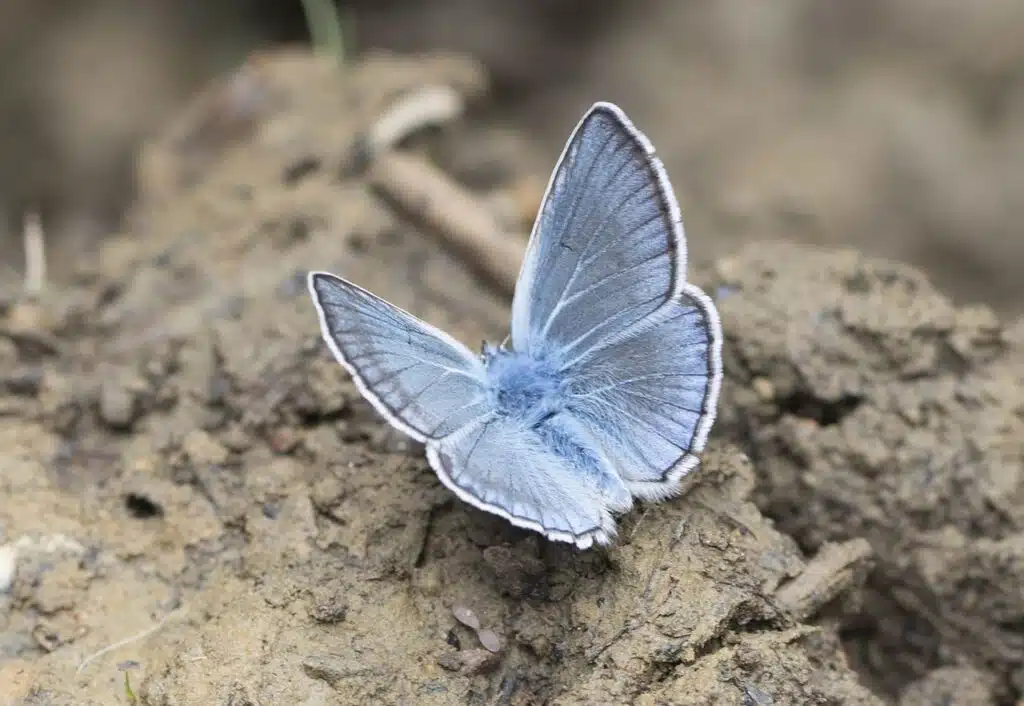
Amanda’s Blue butterflies (Polyommatus amandus) are seen almost everywhere around Europe.
This specie has a few sub-species, also of a blue color.
Male Amanda’s Blue butterflies have a dark blue color or a bright blue color while females are brown.
The coloring of the male depends on its environment. However, all morphs of this species have black and white bordering on the wings and a darker blue body compared to the color of the wings.
Common in wildflowers such as vetch, these butterflies have a short flight season to mid-summer.
32. Indian Wanderer
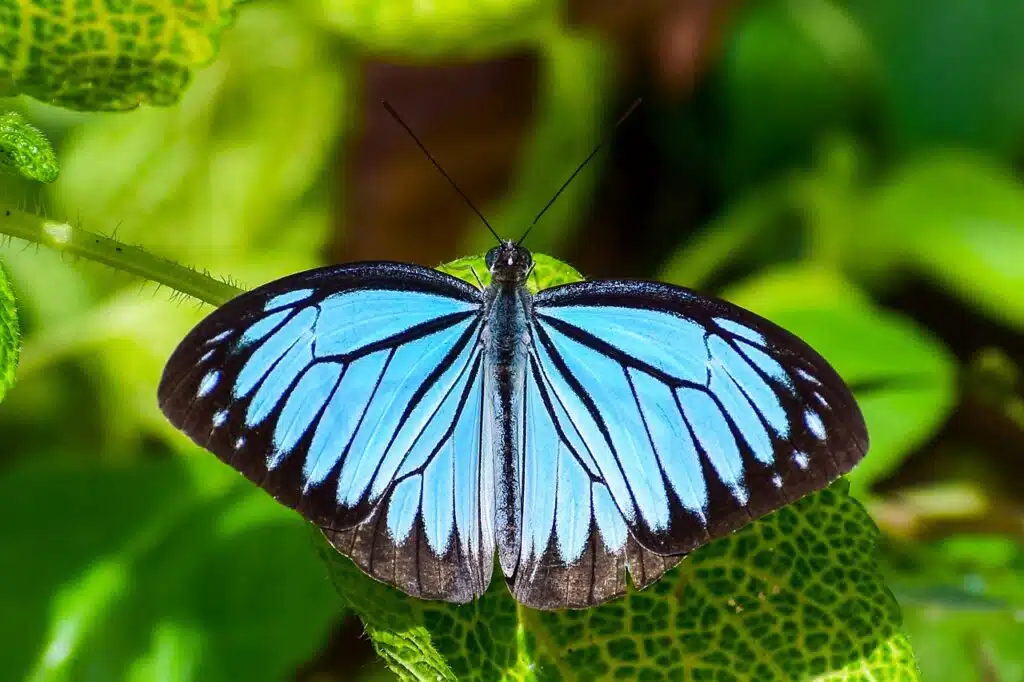
Common in India, the Indian Wandered (Pareronia hippia) is one of the butterflies where both males and females have blue coloring, but of a different shade.
Male butterflies have a more vivid or more pronounced shade of blue with black margins and black marks on the wings.
Females have more black markings and a brighter blue coloring by contrast.
Both can easily be identified as members of the same species.
However, scientific publications classify the Indian Wandered differently as mixed opinions are common regarding this species.
Some scientists regard the Indian Wandered as an independent species while others see it as a subspecies of the Common Wanderer.
33. Mangrove Skipper
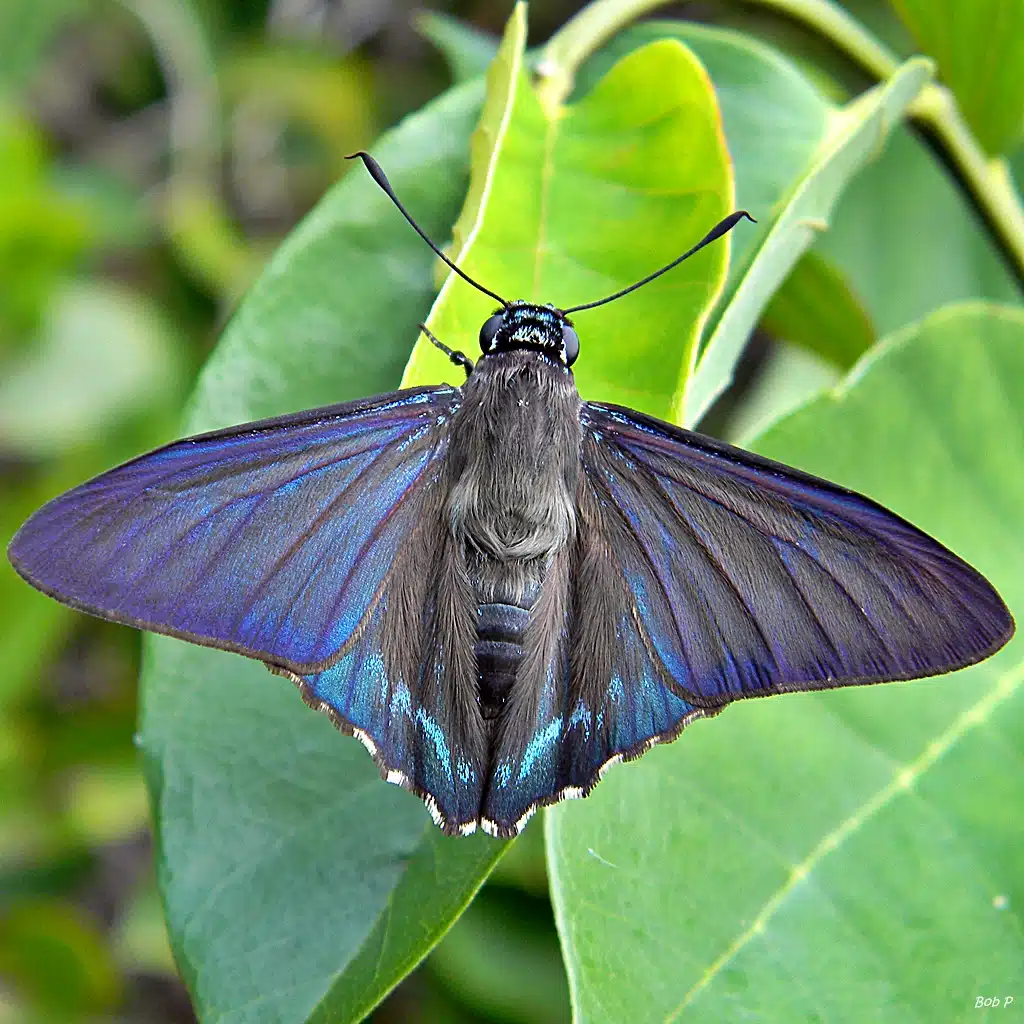
Mangrove Skippers (Phocides pigmalion) are large dark blue butterflies.
The species is common in coastal regions of California as well as in Mexico and Southern American countries such as Argentina.
The coloring of this species is highly specific with mostly black wings with only partial areas where blue and dark blue coloring is visible.
The head, thorax, and abdomen of the species are dark blue with long hairs.
The species appears almost completely black when seen from below.
34. Blue Copper
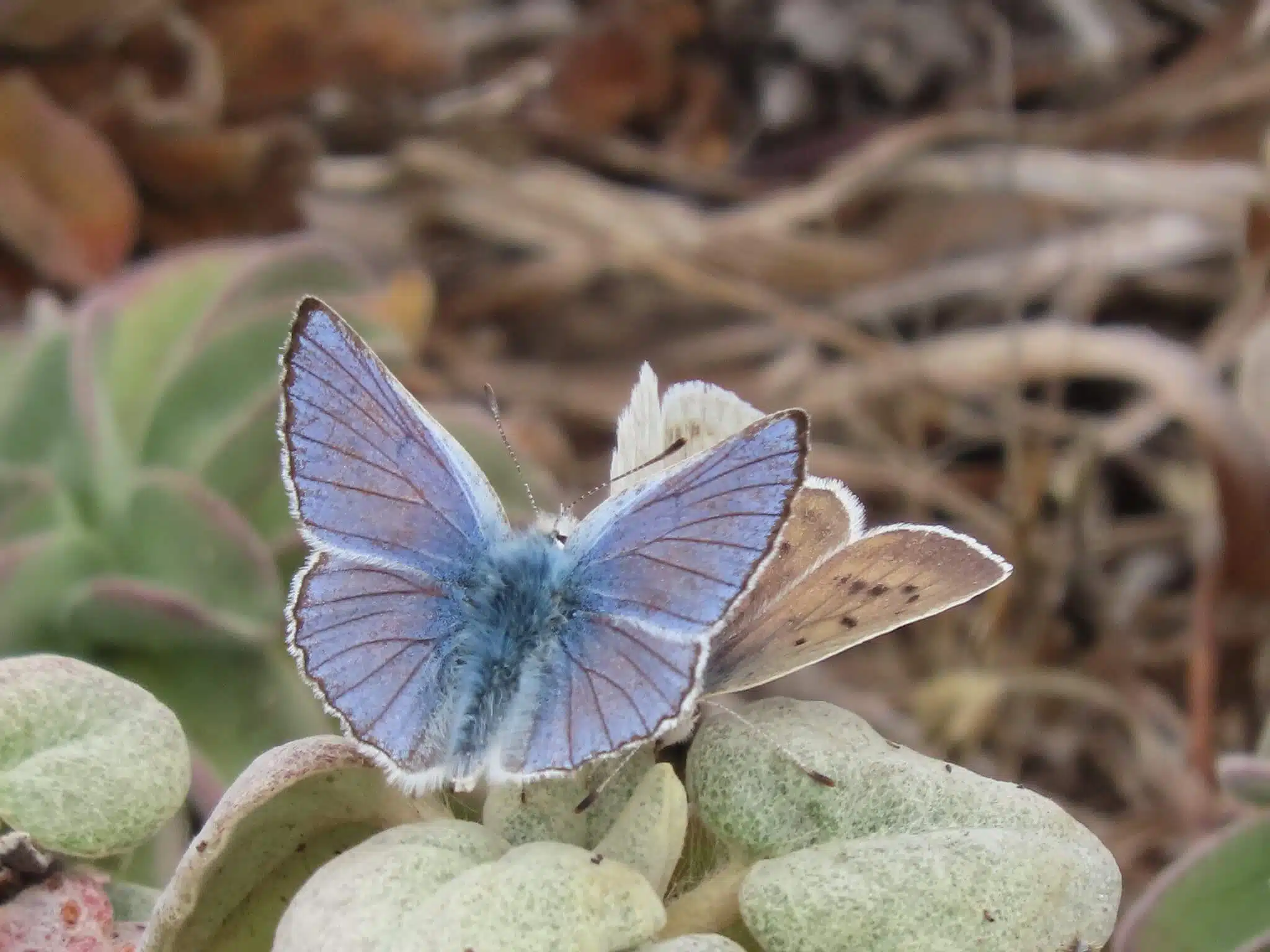
The Blue Copper (Tharsalea heteronea) is a blue butterfly species adapted to living in all territories of Western North America in the US and Canada.
It likes to live in habitats of high elevation but it makes an exception in California.
Blue Coppers have light blue coloring with a few black lines and white margins. The female has a brown color and both sexes have brown spotted undersides.
Blue Coppers are some of the most adaptive blue butterflies in Western North America when it comes to diet as well.
They have a varied diet and are often seen on buckwheat and asters.
35. Reverdin’s Blue
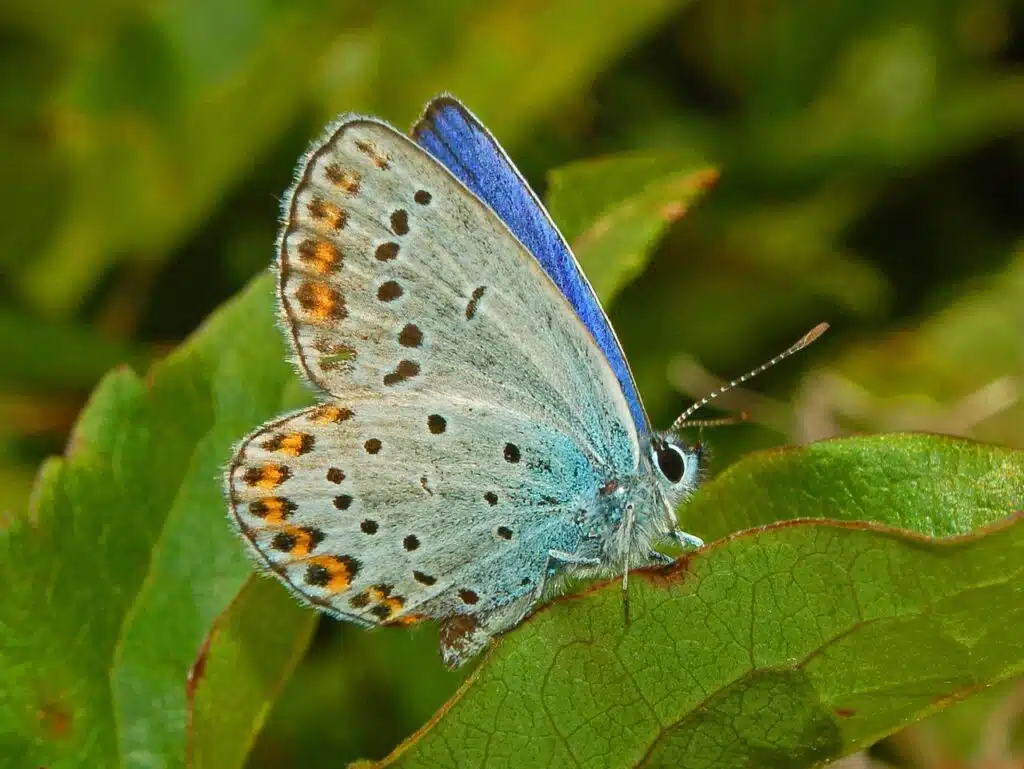
Reverdin’s Blue butterflies (Plebejus argyrognomon) have a sexually dimorphic appearance. Males can appear completely different from females even if they have a few similarities.
One of the major similarities between the male and the female Reverdin’s Blue is the sported forewings and hindwings.
However, the main color of the sexes is different. Only the male is blue.
The blue color of the male’s wings is dark blue with black borders on the edges of the wings.
Even its ventral color is blue but of a much lighter nuance.
Females have a pale pink-orange to salmon color with a large orange band and multiple black spots across the wings, mostly towards the outer edges.
36. Guava Skipper
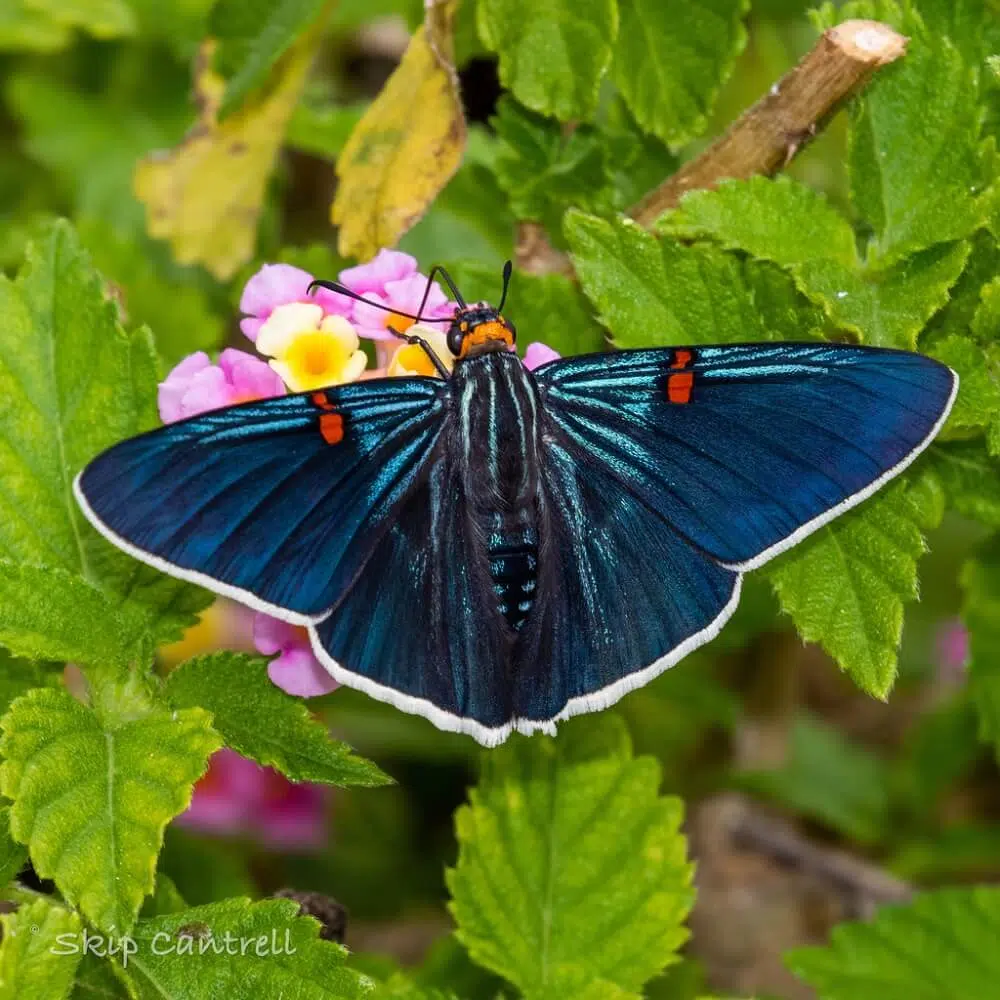
Native to North and Central America, Guave Skippers (Phocides lilea) are seen across Southern Texas.
This species is known for its dark coloring both in males and females, which still look different from each other.
The male has a dark blue almost navy color with light blue stripes and orange spots. There’s an orange spot on the back of its head as well.
Females have a darker body that’s almost completely dark gray to black with light blue stripes and orange-red marks on the wings and the head.
The colored orange-red marks are closer to red than to orange in females compared to the bright spots on the males.
37. Anna’s Blue
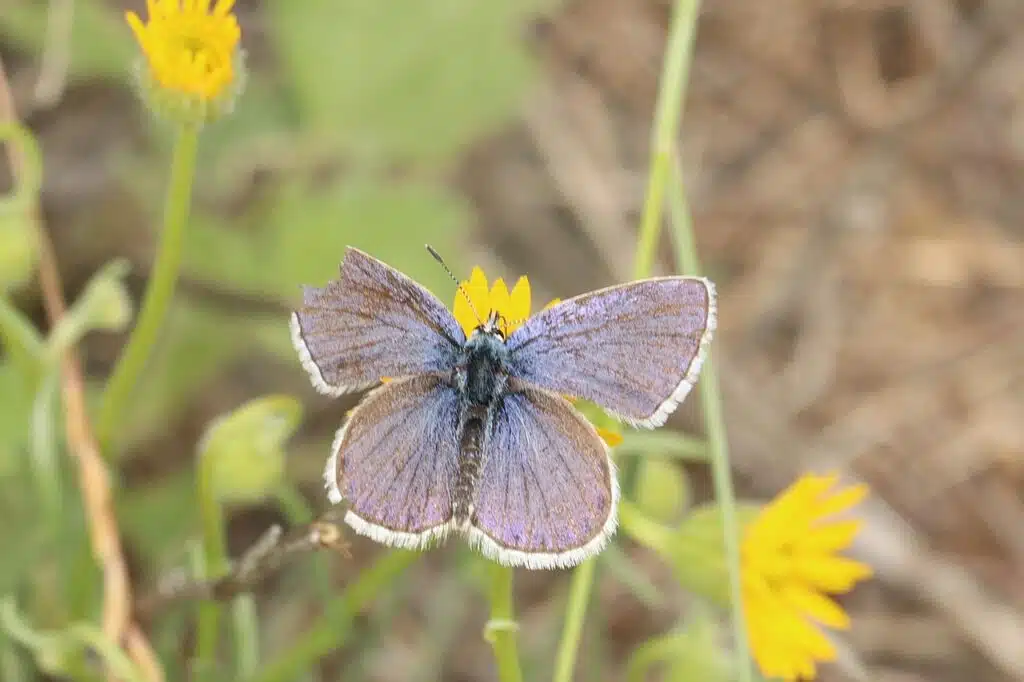
Anna’s Blue butterflies (Plebejus anna) are native and exclusive to North America.
The species is found in scattered populations across Western North America. These butterflies are seen across California in very high numbers.
They’re also present in Oregon, but in smaller numbers.
Anna’s Blue is highly present in Washington state as well as in Vancouver in Canada.
Male Anna’s Blue has a dark blue almost uniform dorsal color and a light blue ventral color.
Females are brown with an orange stripe and black marks on the wings.
The species has a long flight season being active until August.
38. Arctic Blue
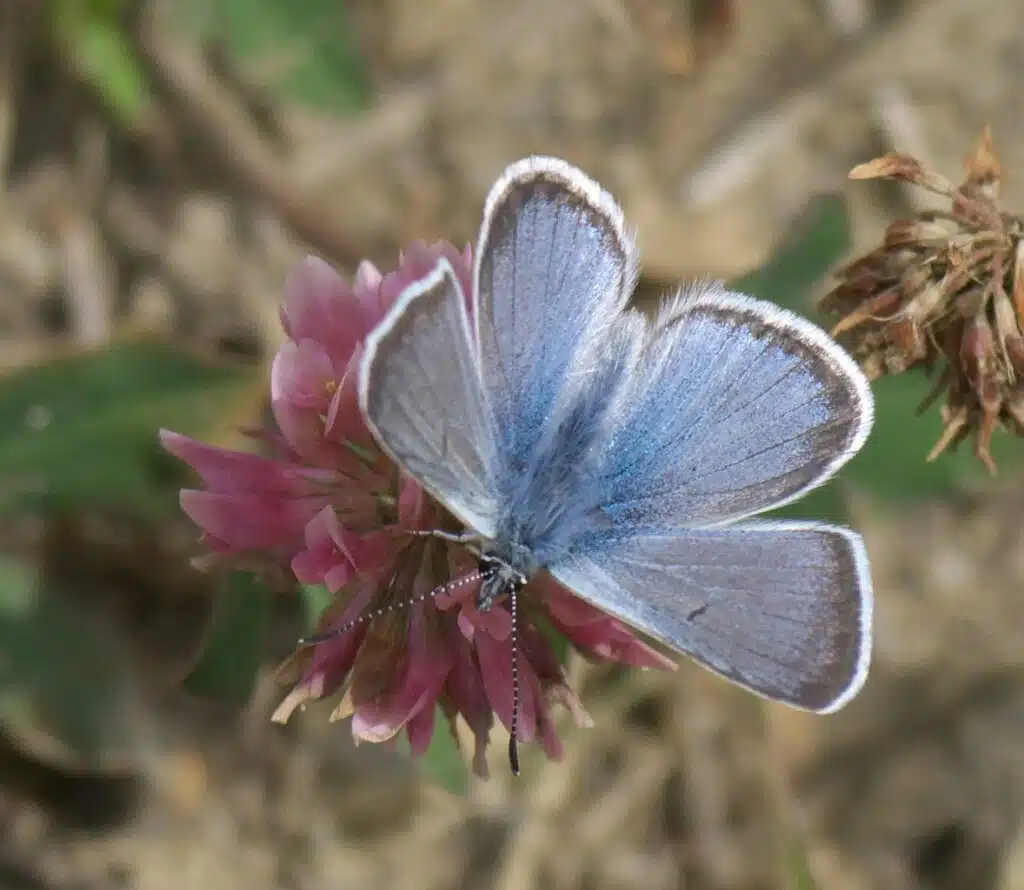
With a wingspan of up to 27mm, the Arctic Blue butterfly (Agriades glandon) is one of the blue butterflies present both in North America and Europe.
This species has a dark blue color that gets darker towards the edges.
Females have a mostly brown color with spots around the edge of the wings.
The flight season of the Arctic Blue varies considerably given it has such a vast range.
Arctic Blue butterflies remain very active until September in warm climates.
They are commonly seen in alpine habitats where they can find plenty of flowers to feed on.
Alpine milkvetch is one of the favorites of the species.
39. Epistrophus White Morpho
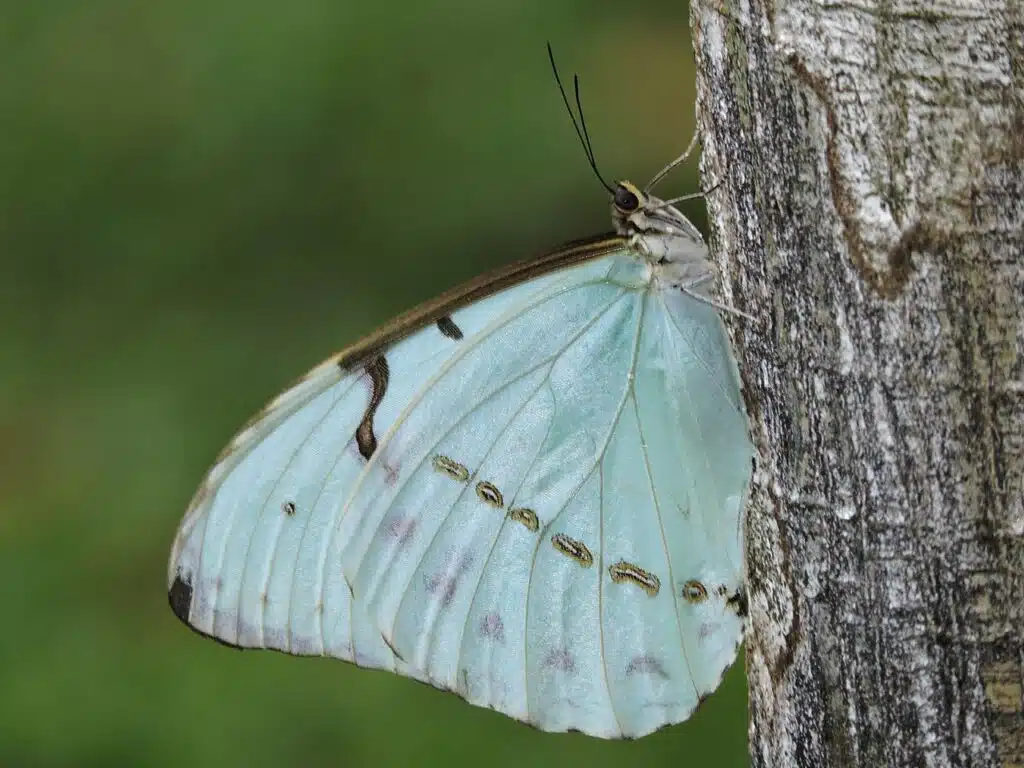
These tropical butterflies (Morpho epistrophus) have a dark blue coloring. As in all Morpho butterflies, this species doesn’t have blue pigmentation.
The blue color comes from iridescence. This means the color blue is a light reflection.
Another surprising fact is that these butterflies have a very uniform blue color given their iridescence which makes them appear blue.
Butterflies of this group are mostly found in forests. They live in both Atlantic and Amazon forests.
40. Periander Metalmark
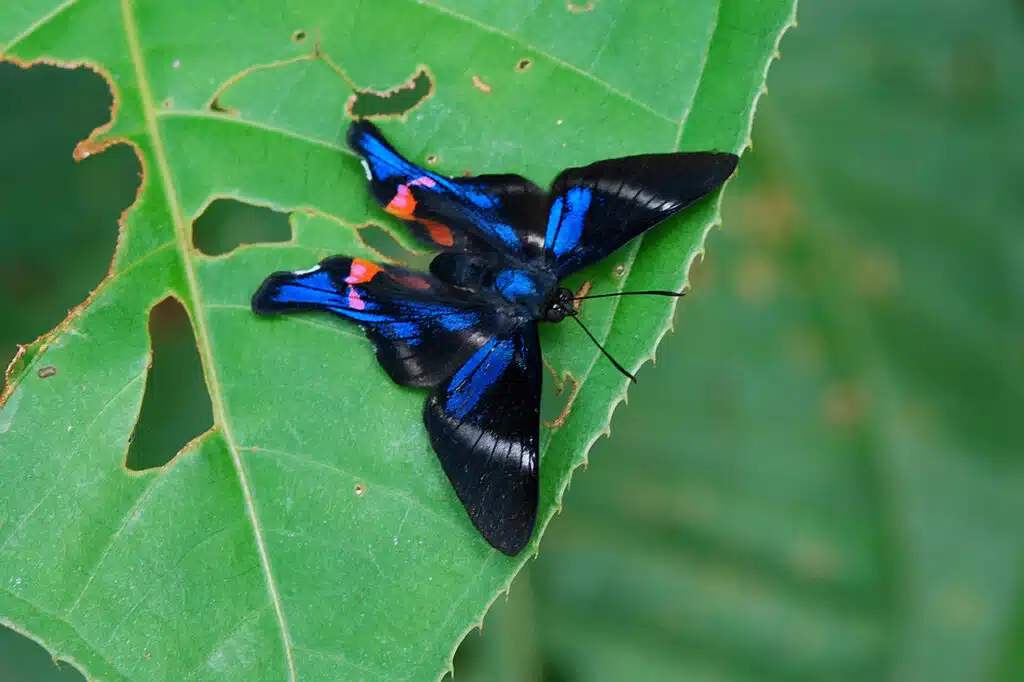
Native to South America, the Periander Metalmark (Rhetus periander) is one of the dark blue butterflies that have orange marks.
These types of colorful marks are common on many blue butterflies, especially on light blue butterflies.
Periander Metalmark butterflies have a dark blue body with black margins and white central bands. Their body is black.
This dark blue nuance of these butterflies can sometimes appear black, especially in low light.
Very common in Central America and sometimes in Southern US, this species has a long lifespan.
41. Starry Night Cracker
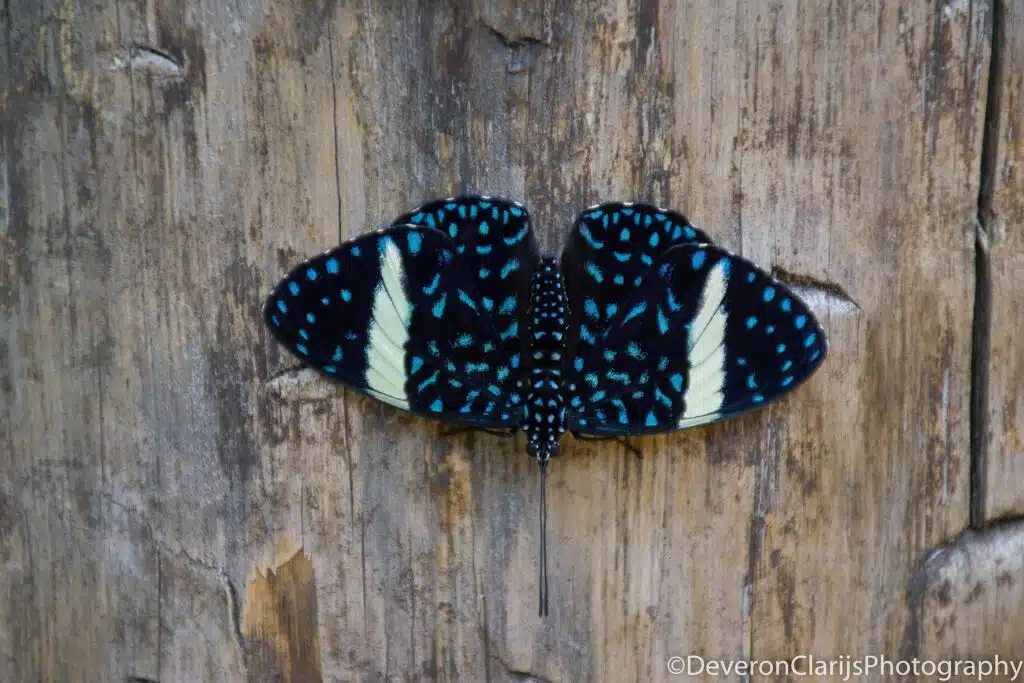
The Starry Night Cracker (Hamadryas laodamia) is one of the species that gets its name from resembling the night sky.
Often compared to stars, the blue spots on its mostly black or navy blue body make this species stand out.
Male Starry Night Crackers have a black body while the female has a black body. Both have colored spots on the wings.
Males have blue spots while females have red spots on the wings.
Common in the Caribbean, these butterfly species are known to live at high altitudes. It can even be found as high as 3.000 feet.
42. Small Green Banded Blue
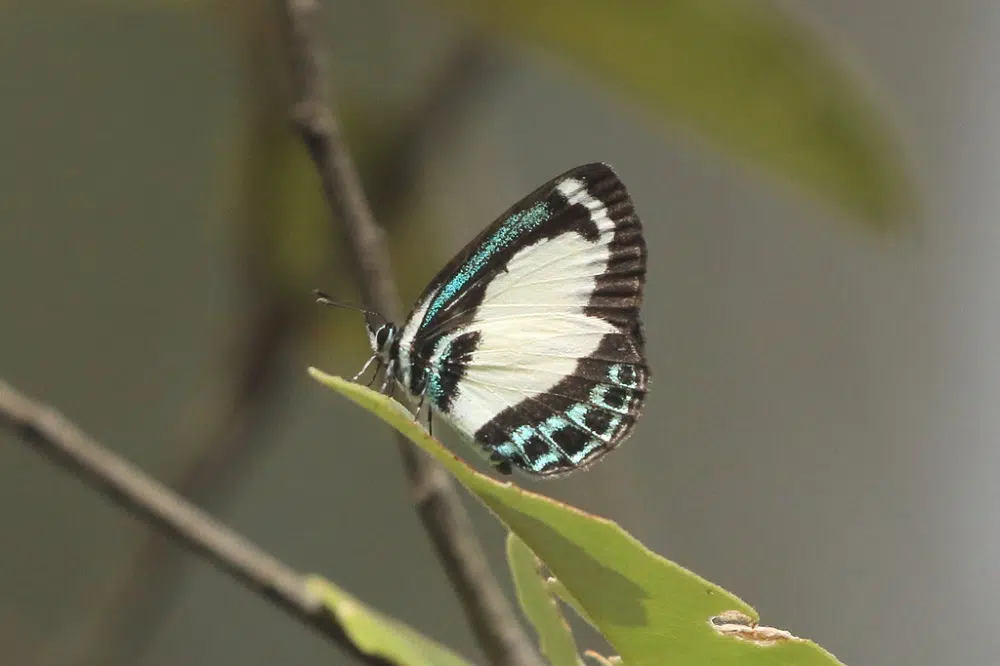
The Small Green Banded Blue (Psychonotis caelius) is a restricted habitat blue butterfly.
It can be found on the islands around Australia, mainly in warm habitats where the Red ash tree grows.
Small Green Banded Blue butterflies need ash trees as this is where their larvae grow.
The larvae of the species feed on the underside of the tree’s leaves.
Male Small Green Banded Blue butterflies have a blue body with a large central white spot while females have a brown body with a large central white spot.
43. Large Blue
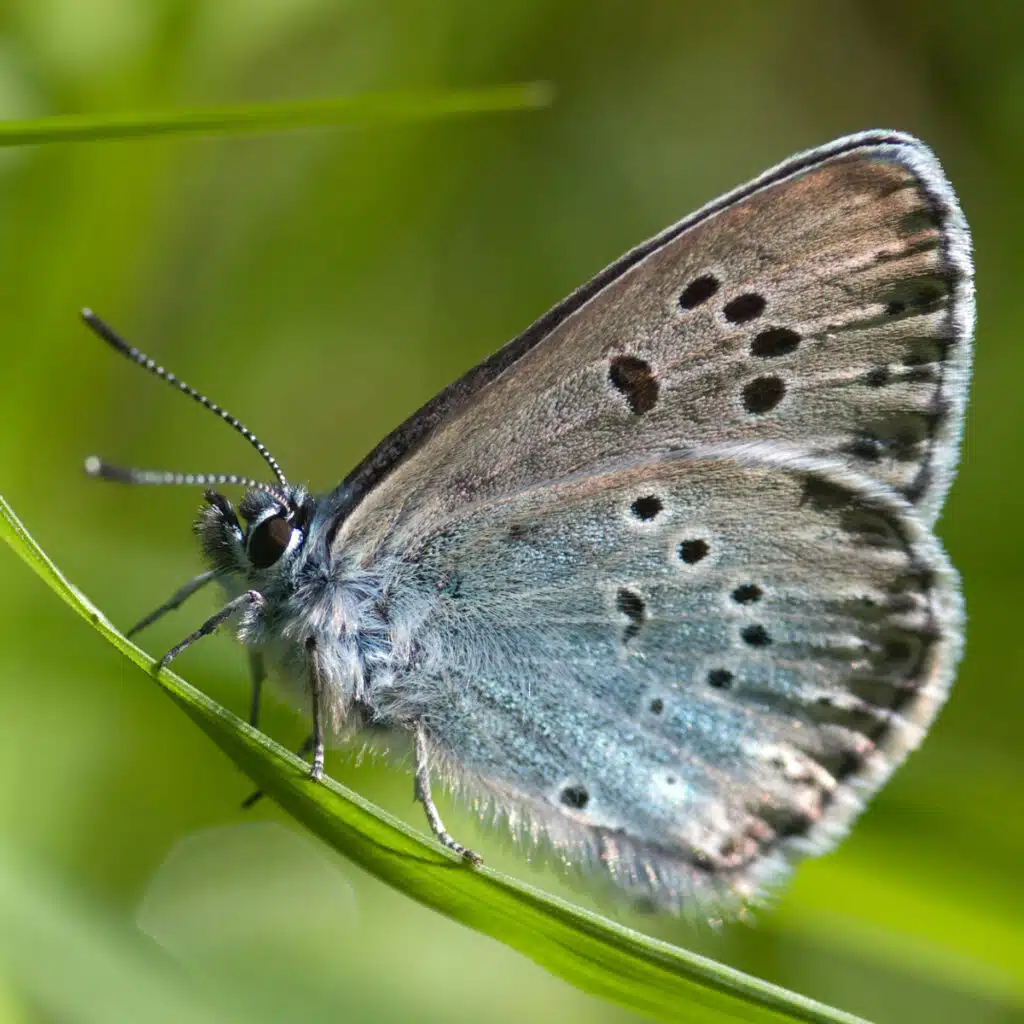
The Large Blue butterfly (Phengaris arion) isn’t specifically large as it grows to about half an inch.
This species has blue coloring both on the dorsal and on the ventral sides.
Large Blue butterflies have blue and black colors dominating the dorsal side.
Light blue coloring with black speckles are characteristics of its ventral side.
Females of the species have a brown color.
Large Blue butterflies have a widespread presence around the world, but not in North America. They are widely found in Europe and all parts of Asia.
The species is still considered endangered in some countries by the reduced natural habitat.
44. Menelaus Morpho
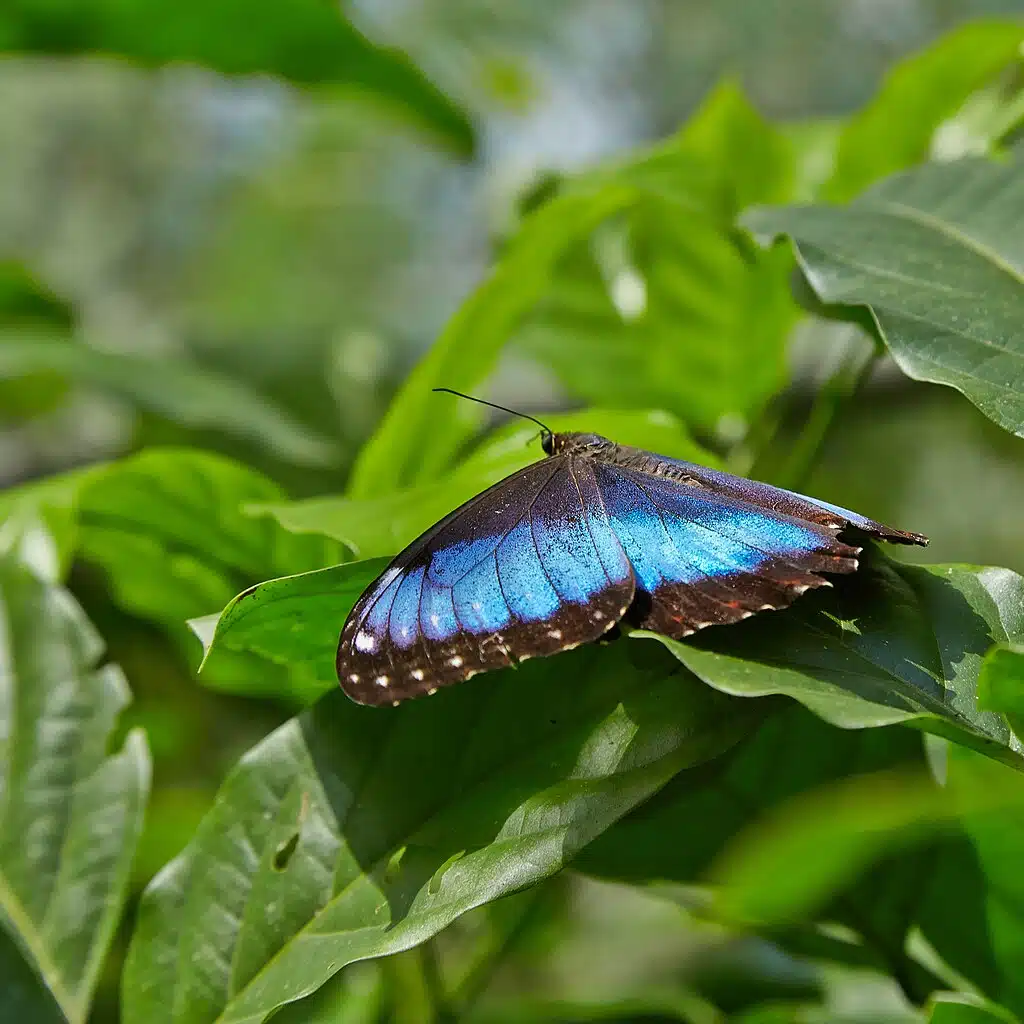
The Menelaus Morpho (Morpho menelaus) is a blue butterfly specific to Central America and North America.
The species is present in vast numbers in Brazil’s large forests as well as in Mexico.
It has an iridescent blue color with dark blue and light blue hues and black margins on its wings.
Menelaus Morpho is a species that appears at the beginning of the rainy season as it’s favored by humidity for reproduction.
Butterflies of this genus lay eggs on plants, typically on the underside of the leaves for better protection.
Menelaus Morpho eggs are green to further reduce the risk of predation.
45. Chapman’s Blue
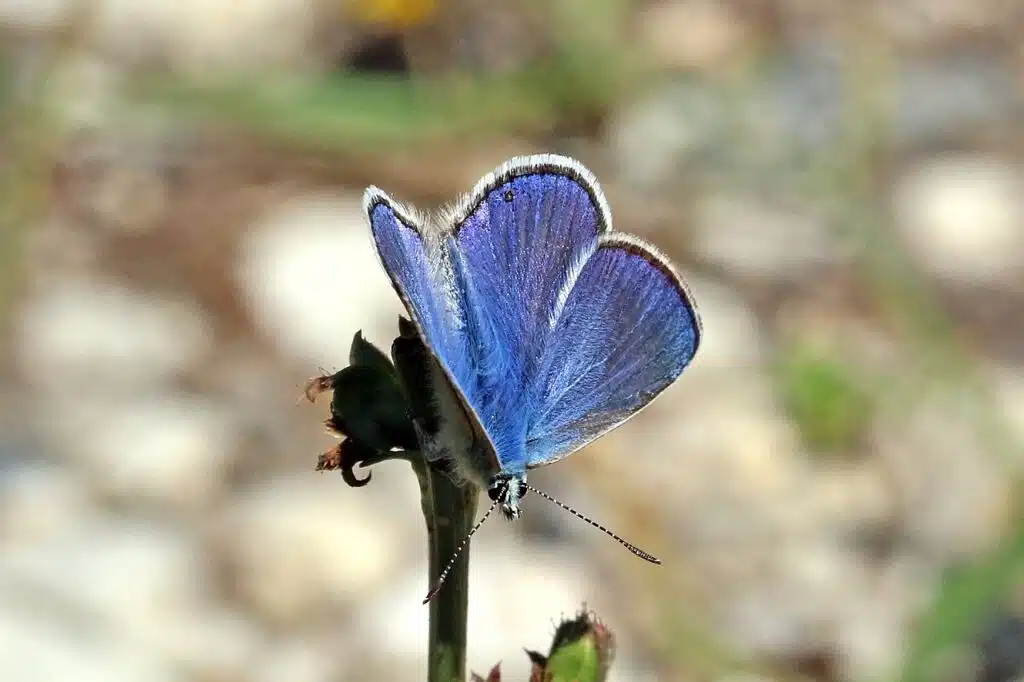
Chapman’s Blue butterflies (Polyommatus thersites) are found in Southern Europe, Northern Africa, and Asia.
The species is known for its deep blue color with black and white margins in the case of males and a brown wing color in the case of females.
The underside of the species is also vividly-colored. Chapman’s Blue butterflies have an underside with black dots with white margins.
Chapman’s Blue lay eggs in very specific vegetation. The larvae of the species need to feed on sainfoins perennial herbs.
46. Black-patch Bluemark
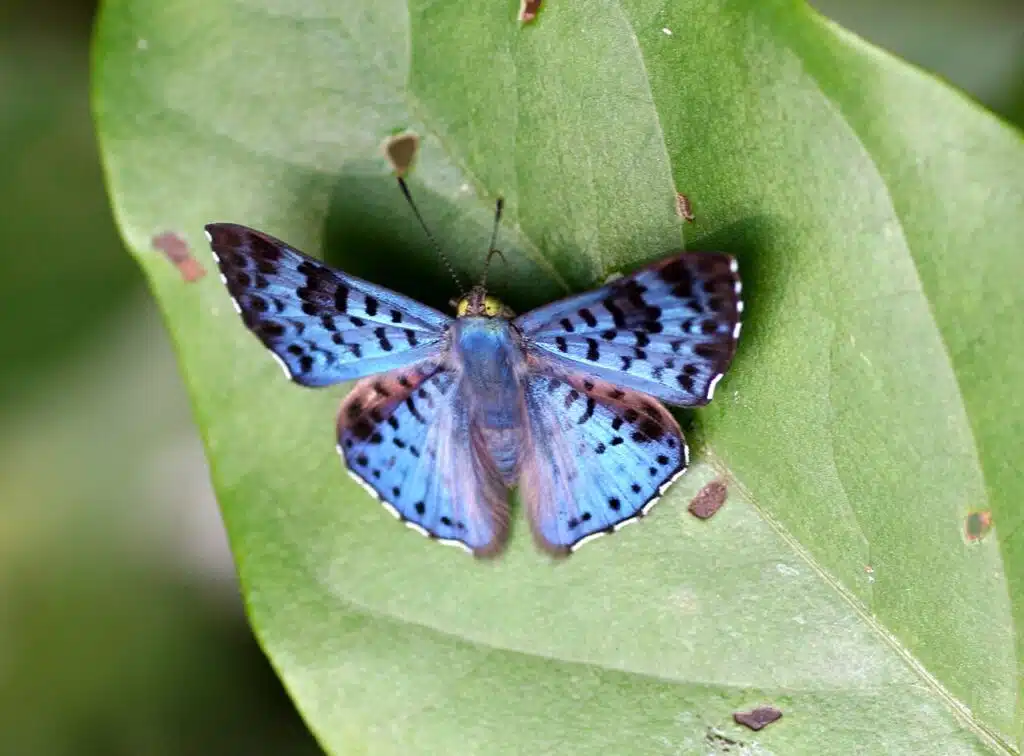
Black-patch Bluemark butterflies (Lasaia agesilas) have a metallic shiny blue color with yellow-white sections.
The head of the Black-patch Bluemark has a yellow-green head.
Native to Central and South America, the butterfly also has a vividly-colored metallic blue body.
The ventral side of its wings is mainly brown with dark brown patches. It can also be tan instead of brown.
47. Blue Metalmark
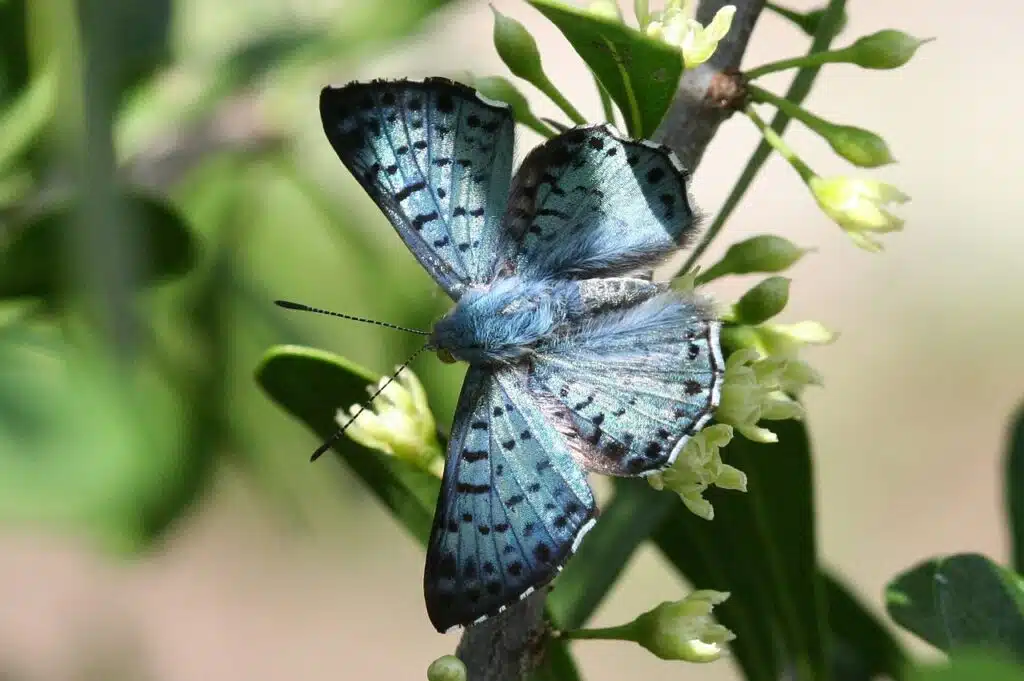
Blue Metalmark butterflies (Lasaia sula) are among the versatile species that live in or near woodlands as well as on agricultural fields.
The species is mostly tied to subtropical forests but it can be found in remote areas of Southern Texas.
This species is rather small as the largest Blue Metalmark butterflies have 1.2 inches.
In terms of color, the Blue Metalmark is true to its name. It has dark blue and light blue coloring on its wings. The margins of these wings have thick black colors as well as black spots.
The ventral side of the species has brown color with brown spots.
48. Orsis Bluewing
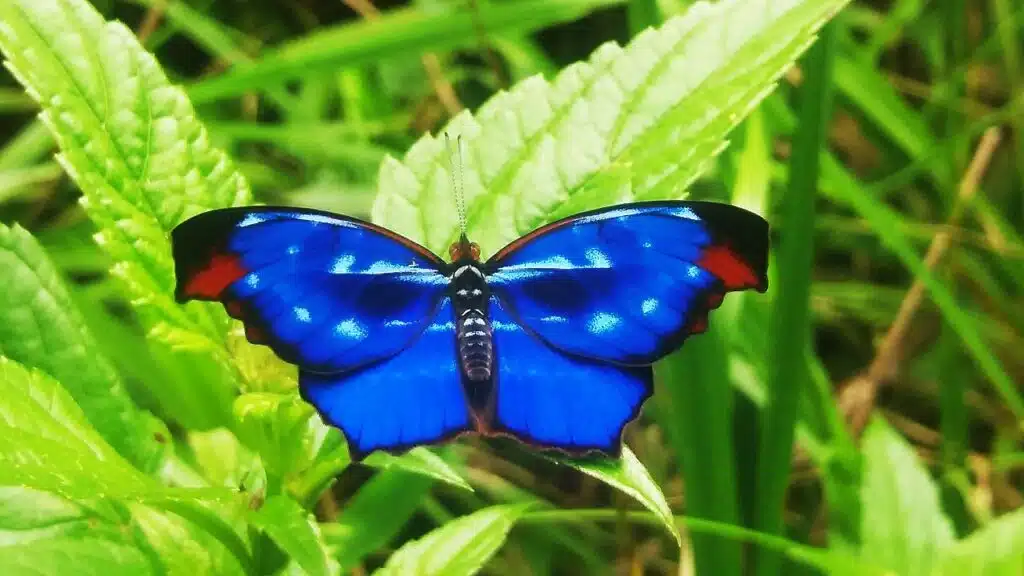
Orsis Bluewings (Myscelia orsis) is a blue butterfly species native to South America and Brazil’s rainforests.
The species is among blue butterflies that have blue wings and a different color body.
Orsis Bluewings have a brown body and dark blue wings.
These wings have a few black stripes which add contour but the black bands also cross the wings from the body to the wing edges.
With a wingspan of up to 2.2 inches, Orsis Bluewings also have very long antennae.
Some butterflies of this species also have an orange-red banding around the wings with light blue spots and 2 black spots on the wings.
49. Cydno Longwing
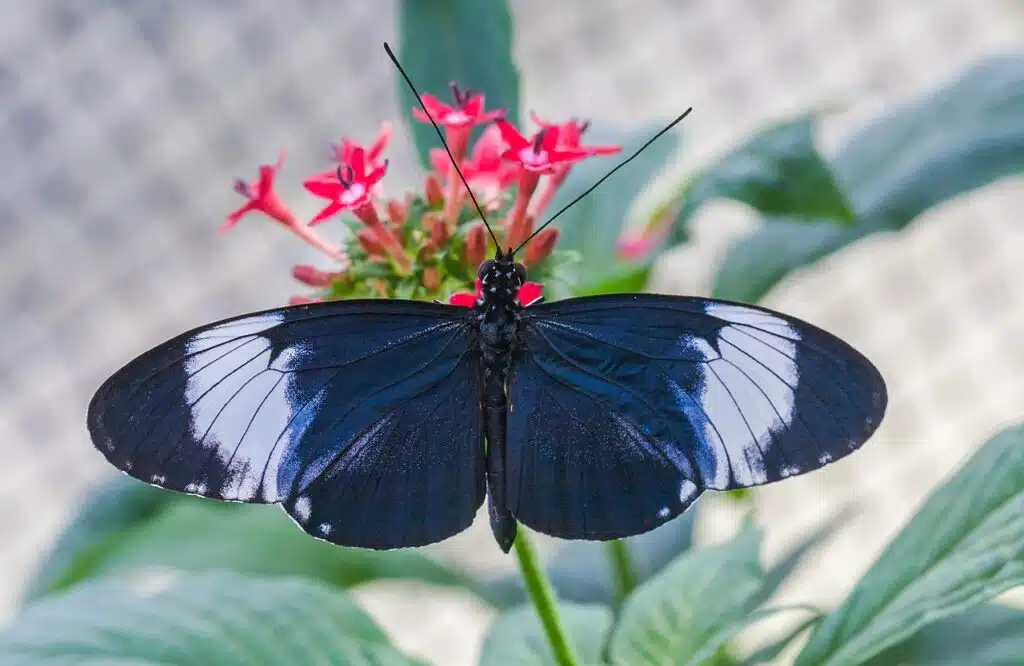
Cydno Longwing butterflies (Heliconius cydno) are native to Central America and South America.
This species is mostly found on the flora on the forest floor. This is where these butterflies live and mate.
They come in various colors but have blue iridescence. This vivid blue tint makes these butterflies attractive.
It’s believed they rely on this blue hue to attract mates since there’s a reduced amount of natural light on forest floors.
The behavior of this species is social. Females prefer to mate with multiple mates to ensure reproductive success and to establish the most resources in a territory when it comes to offspring.
The female Cyndo Longwing butterfly deposits eggs on Passion vines, a type of violet flower with hundreds of sub-species.
These butterflies are common in Mexico and Ecuador as a result.
They never leave forests as they prefer this specific habitat even if their forests are at altitudes of up to a few thousand feet.
50. Southern Guava Skipper
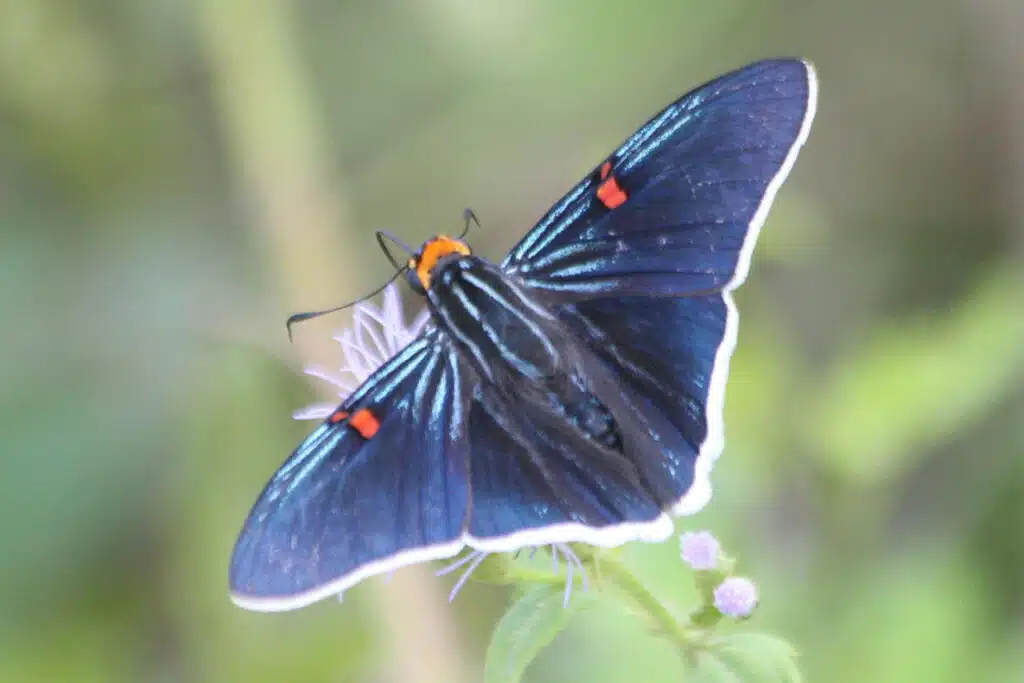
Southern Guava Skippers (Phocides polybius) are most common in areas South of Rio Grande Valley in Texas.
They are further common in parts of Mexico and South America.
The Southern Guava Skipper looks similar to the Guava Skipper with its dark body.
Dark blue to black, this butterfly species has light brown coloring and orange spots on the top of its wings. A smaller orange spot is further identifiable on its head.
The body is mostly black with some blue stripes on the thorax.
The species feed on flower nectar and it lays eggs on leaves as well.
Larvae of the species change coloring as it grows. It has a white color with a red, yellow, and black head at first.
It then turns red, black, and yellow.
The larvae of the Southern Guava Skipper are found on the underside of leaves on flowers adults feed on.
51. Holly Azure
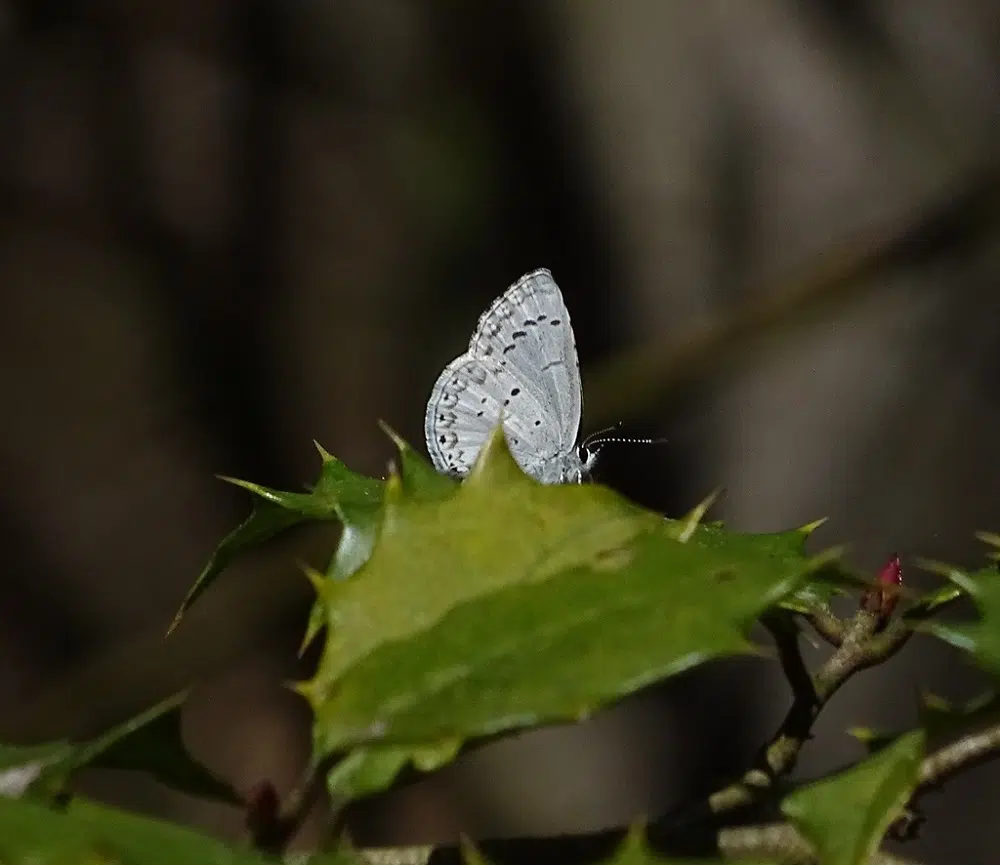
Holly Azure (Celastrina idella) is a butterfly native to Eastern US. It lives in extended habitats from New Jersey to Georgia.
You can identify this species by its light blue color. Males have a slightly darker shade of blue while females have a light blue color with silver-white undertones.
Both males and females have small black spots on the wings.
These butterflies are active from late February when the temperature allows them to pupate.
Adult Holly Azures are known to feed on nectar and they prefer nectar from many fruit trees and bushes.
They eat Aronia nectar, blueberry nectar, and rock cress among others.
Apart from visiting these fruits, Holly Azures are known for their love of coastal habitats. This is why they always live in wet areas such as maritime forests and swamps.
52. Shasta Blue
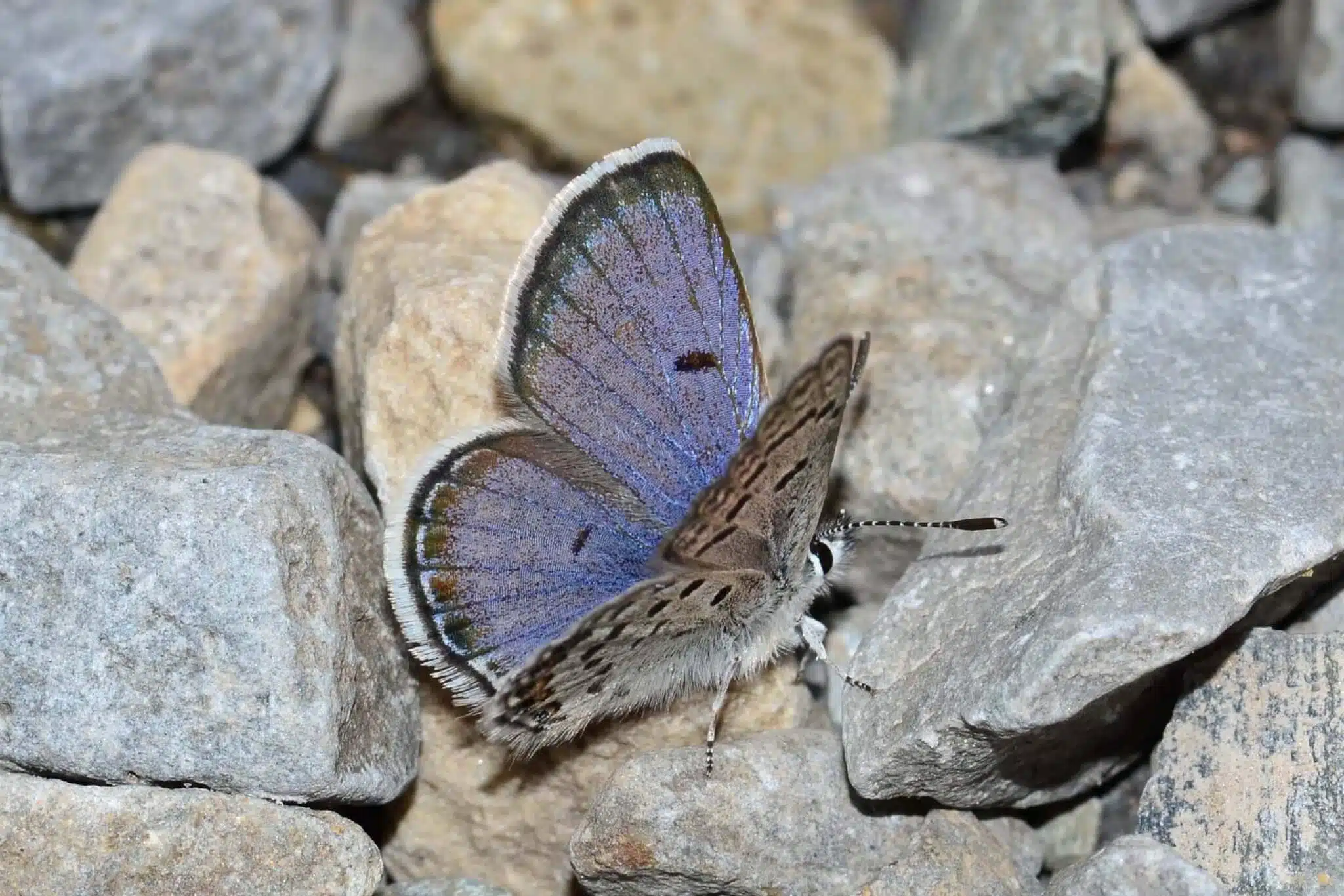
Known for its blue color, Shasta Blue butterflies (Icaricia shasta) are seen in Northwestern US as a species that lives up in mountains.
The species has a light blue color with black spots. It also has multiple small gray spots making it appear slightly darker both on the dorsal and ventral sides.
Shasta Blue butterflies are known for appearing late in the season due to living at high elevations.
The first generation appears in June and its flight season continues to late summer.
Butterflies of this genus have a wingspan of up to 22mm and can be admired around Dwarf mountain lupine shrubs in Northwestern US.
53. Silver-studded Blue
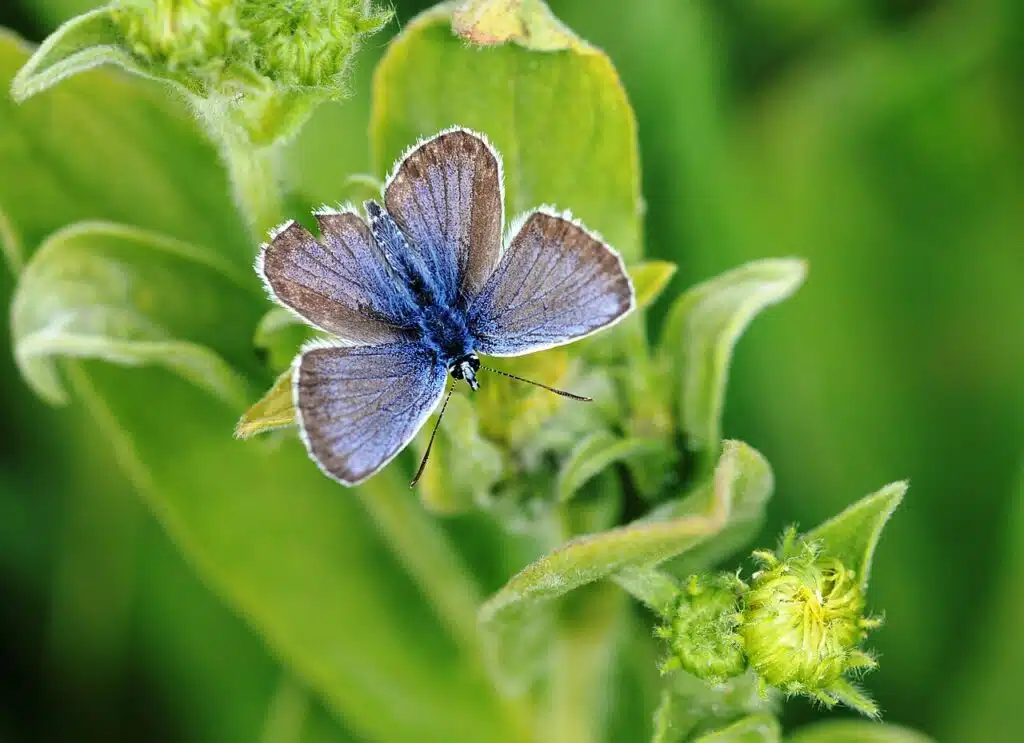
Silver-studded Blues (Plebejus argus) are common in Europe, especially in the UK. This species lives in shrubland and moss land.
Known for its colorful body, the butterfly has different nuances of blue.
It has darker blue towards the edges of the wings and lighter blue towards the body.
Butterflies of the genus have a white margin around the wings.
Dark blue to black coloring is specific to its head and thorax.
Silver-studded Blues are butterflies that live in mutuality with ants, mainly for protective purposes.
The species is found around rock rose and the sun rose and never flies away more than 60 feet at a time.
54. Blue Admiral
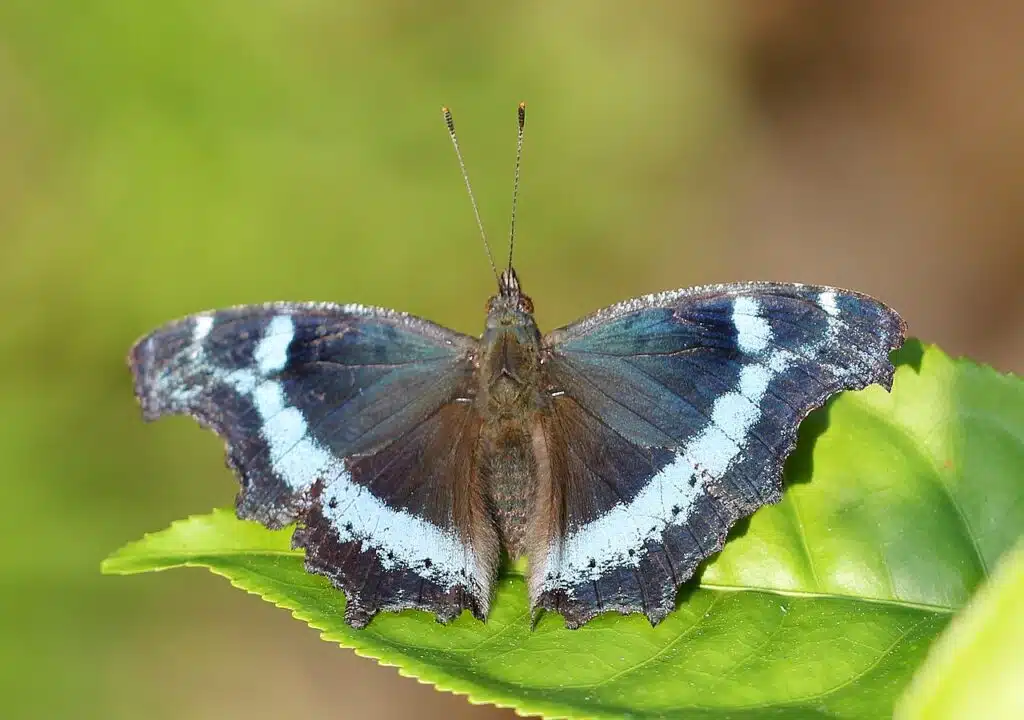
The Blue Admiral (Kaniska canace) is a large species with a mostly black body with large blue sections on its wings and blue overlays on its black body.
The underside of the wings is brown, yellow, and black.
Common in Asia, Blue Admirals are seen in regions such as Siberia, Taiwan, and Japan.
Blue Admiral is known as aggressive butterflies in the case of males.
They do not allow any other butterflies to come into their territory. This is tied to mating strategies as males exert dominance over a territory to attract females.
55. Acmon Blue
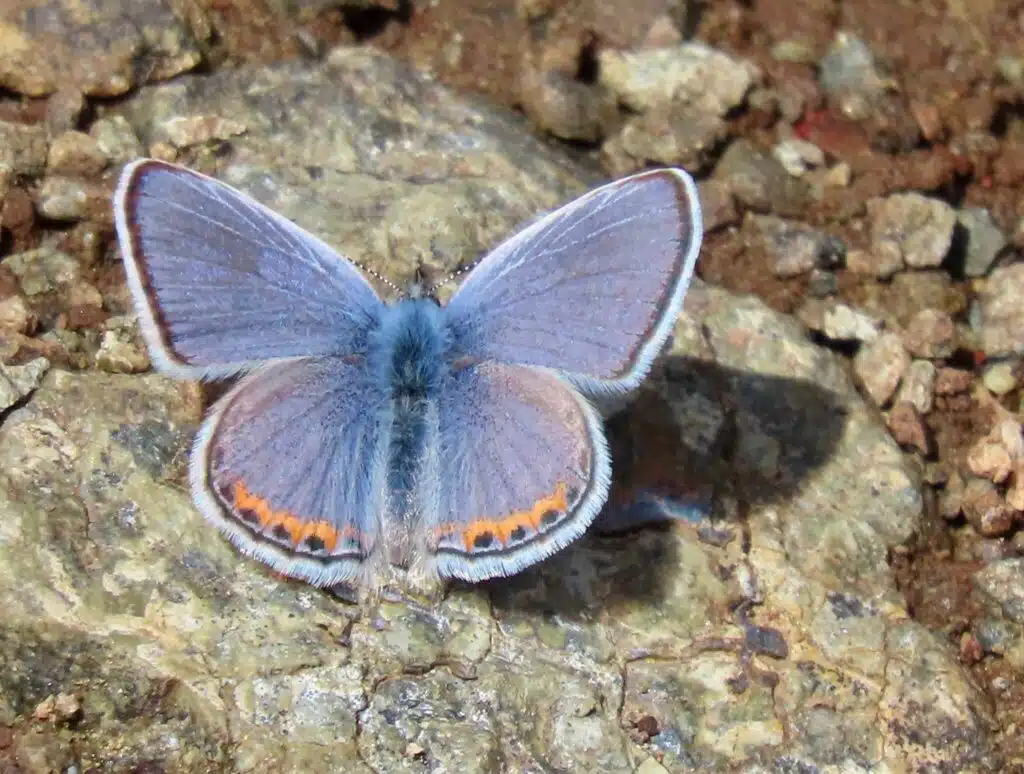
This blue butterfly (Icaricia acmon) has black margins, and black, and orange spots.
Native to North America, Acmon Blue butterflies are most common in California and further out in Oregon.
Acmon Blue butterfly larvae live together with ants in a mutually-beneficial relationship.
Ants protect larvae from predators while they get to consume the sugary honeydew larvae produce from eating deer weed and lupiens.
Adult Acmon Blues feed on nectar.
The species can reach a wingspan of up to 30mm in the presence of abundant nectar sources.
The butterflies can be spotted easily both when flying and while resting with their wings close together as the underside of the wings is black.
Acmon Blue butterflies can be found in a wide range of habitats specific to California.
This includes deserts and prairies.
Further Reading: